

Damion Smy
Boxy new KGM Musso unveiled to take on HiLux and Ranger ahead of Australian launch
8 Hours Ago
Can't get a LandCruiser, and want a big three-row SUV with lots of kit and decent off-road ability? Check out these two.

News Editor
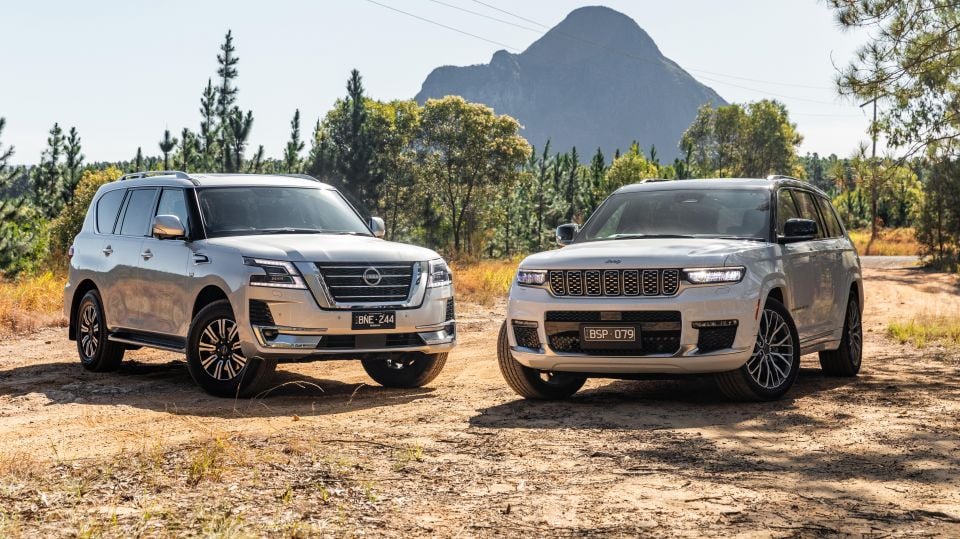

News Editor
The Toyota LandCruiser 300 Series was one of the most hotly anticipated vehicle launches in recent memory.
It’s still hotly anticipated by many customers, as Toyota struggles to get supply of its large SUV. Perhaps as a consequence, the Nissan Patrol – itself no stranger to supply issues – has been steadily ticking upwards in sales.
Entering this arena is a new flagship Jeep: the Grand Cherokee L. It’s not quite conceptually the same type of SUV as these stalwarts, however.

A stretched, three-row version of the upcoming WL Grand Cherokee, it occupies a space in the Jeep lineup that’s been vacant since the Commander was axed in 2010.
It’s petrol-only like the Patrol, but with a V6 instead of a V8. A plug-in hybrid is coming – something neither the Patrol nor LandCruiser can offer – but only in the shorter two-row model.
But while the big Nissan and Toyota are traditional, body-on-frame SUVs, the Grand Cherokee L features unibody architecture. Jeep has a more direct rival in the likes of the Wagoneer and Grand Wagoneer, but it’s not available in right-hand drive.
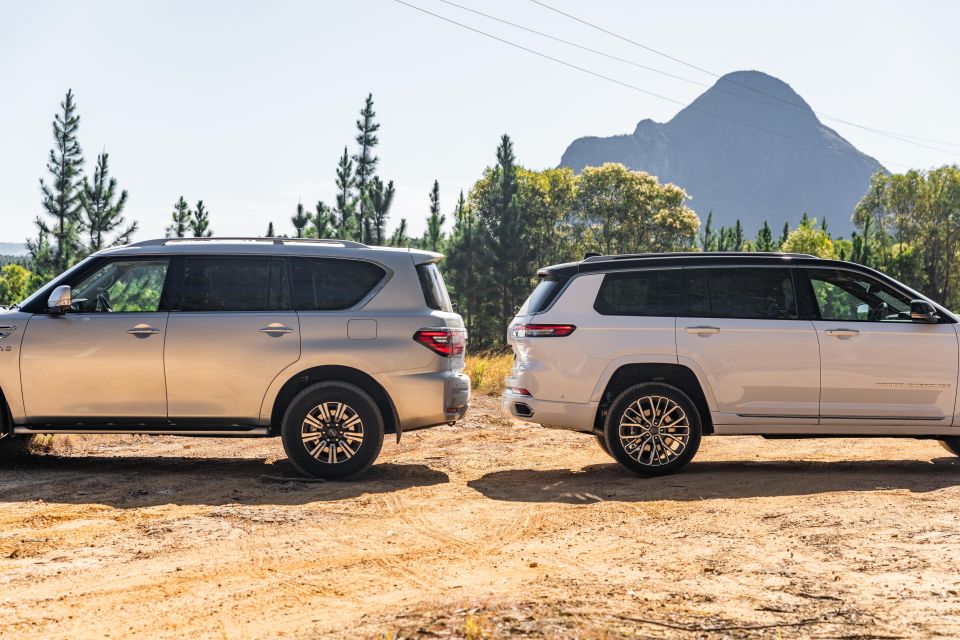
The grass is always greener on the other side, isn’t it?
In the USA, the land of large SUVs, the flagship Jeep Grand Cherokee L can be had with a petrol V8 engine. It’s priced right up against a top-spec Nissan Armada Platinum, the US-market version of the Patrol complete with a completely overhauled interior.
In Australia, we have no such luck. The Grand Cherokee L is a petrol V6-only affair, and the Patrol sticks with a 2010-vintage interior. The pricing is skewed too, with a whopping $20,000 gap between flagship Grand Cherokee L and Patrol offerings.
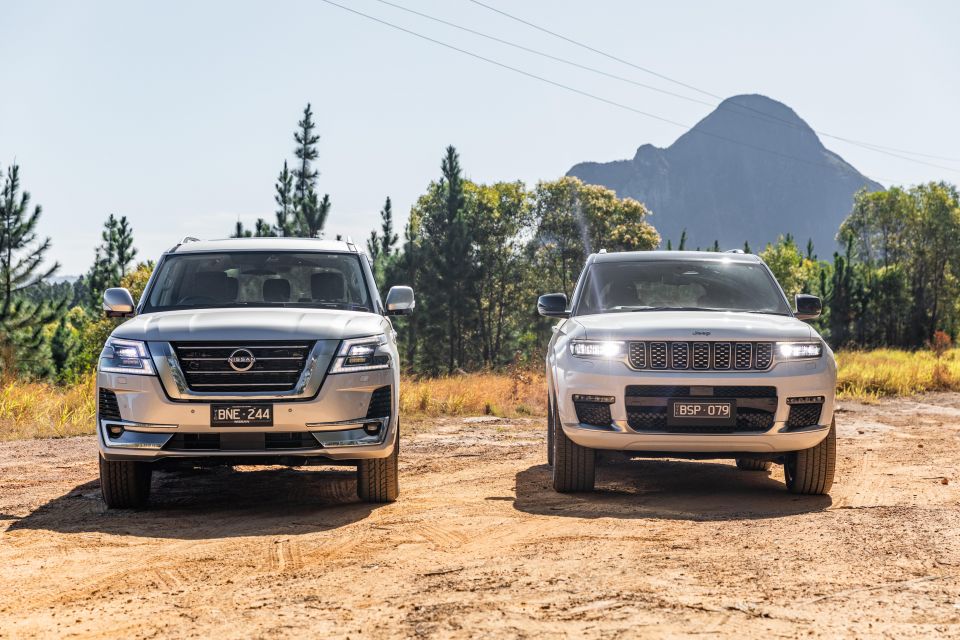
We’ve pitted these flagship variants against each other: the Patrol Ti-L, at $95,115 before on-road costs, and the Grand Cherokee L Summit Reserve at an eye-watering $115,450 before on-roads.
Drive-away pricing, based on a Sydney post code, is $103,202 for the Patrol and $126,525 for the Grand Cherokee L – plus an extra $5500 for the latter’s Advanced Technology Group.
All bar Gun Metallic costs an extra $650 on the Patrol, while all bar Bright White costs a significant $1750 on the Grand Cherokee L.
You can get more affordable versions of both SUVs. The Patrol Ti costs $82,160 before on-roads, while the Grand Cherokee L can be had in Night Eagle and Limited trims at $82,250 and $87,950 before on-roads, respectively.
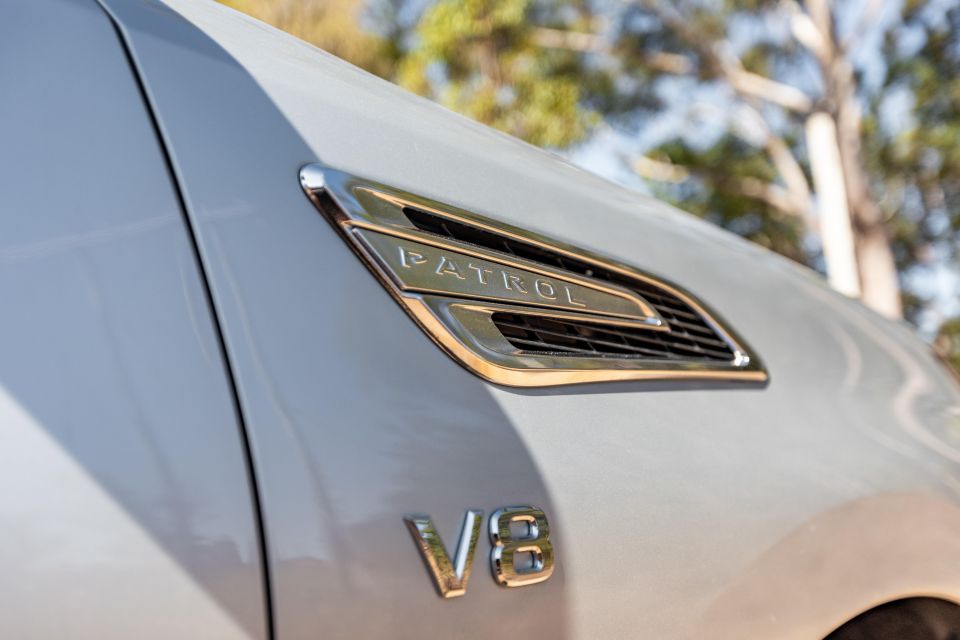
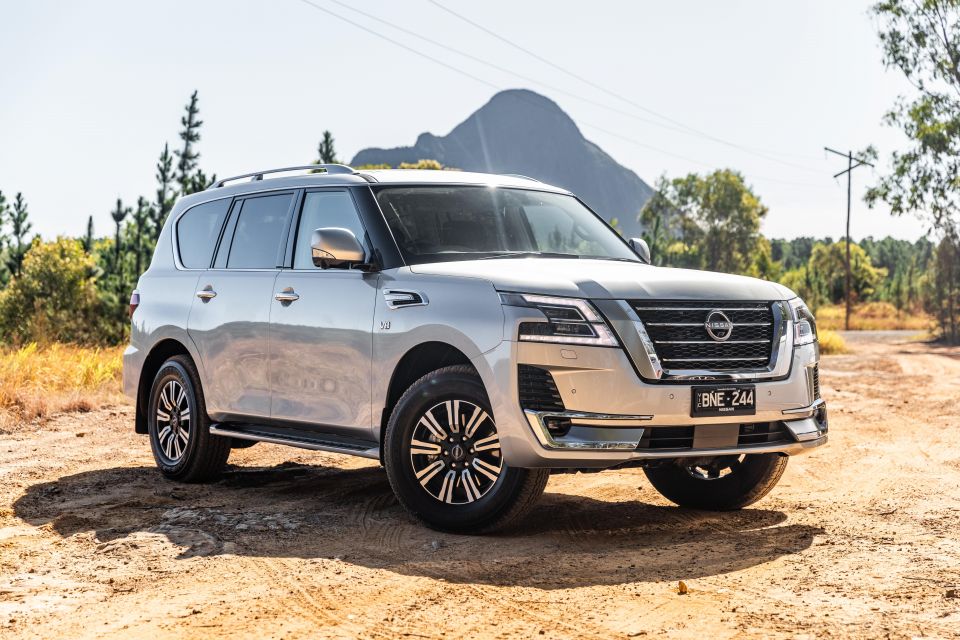


Standard equipment common to both cars includes:
Standard equipment unique to the Grand Cherokee L Summit Reserve includes:
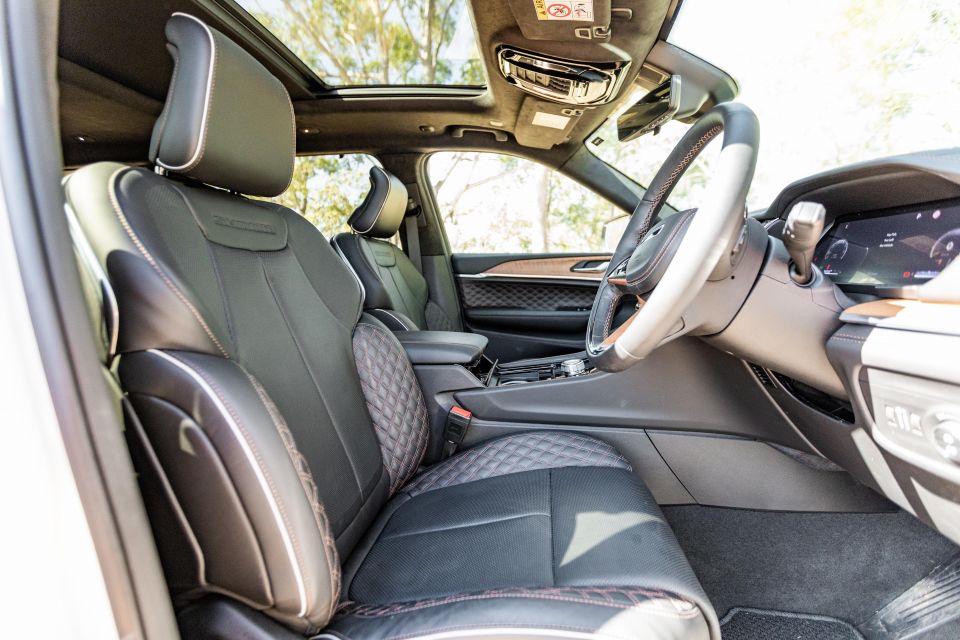
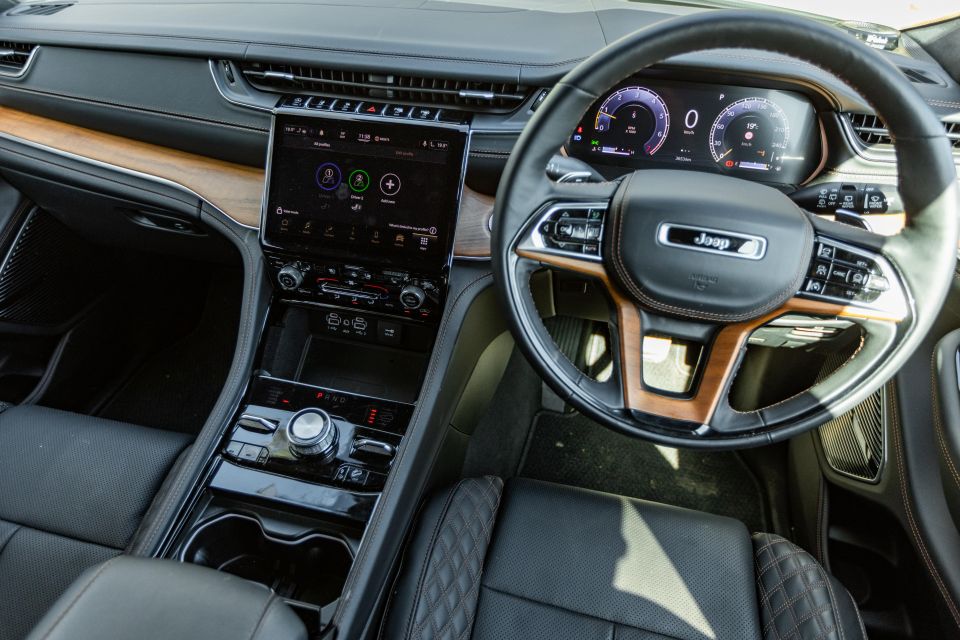
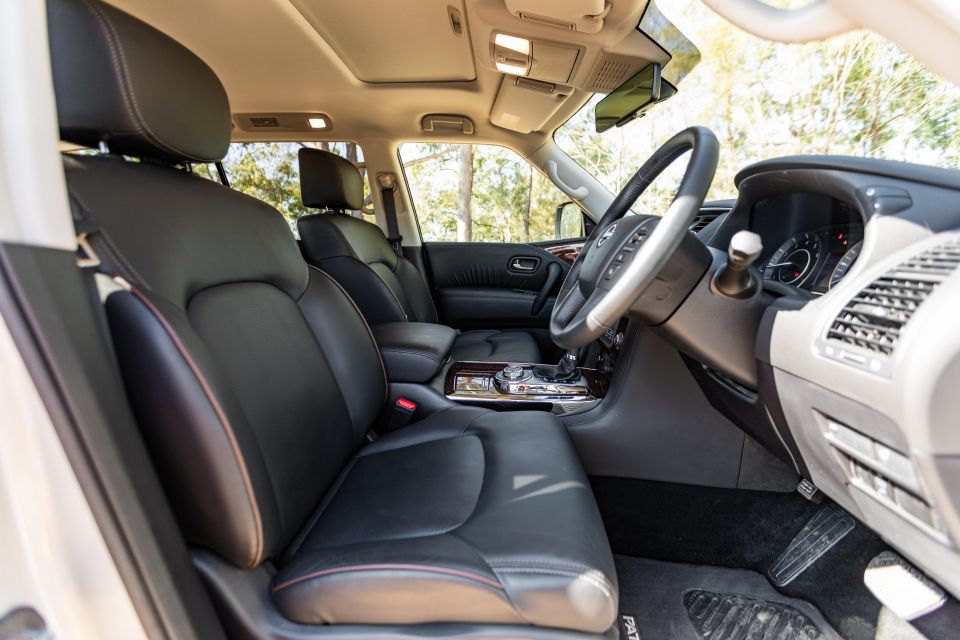
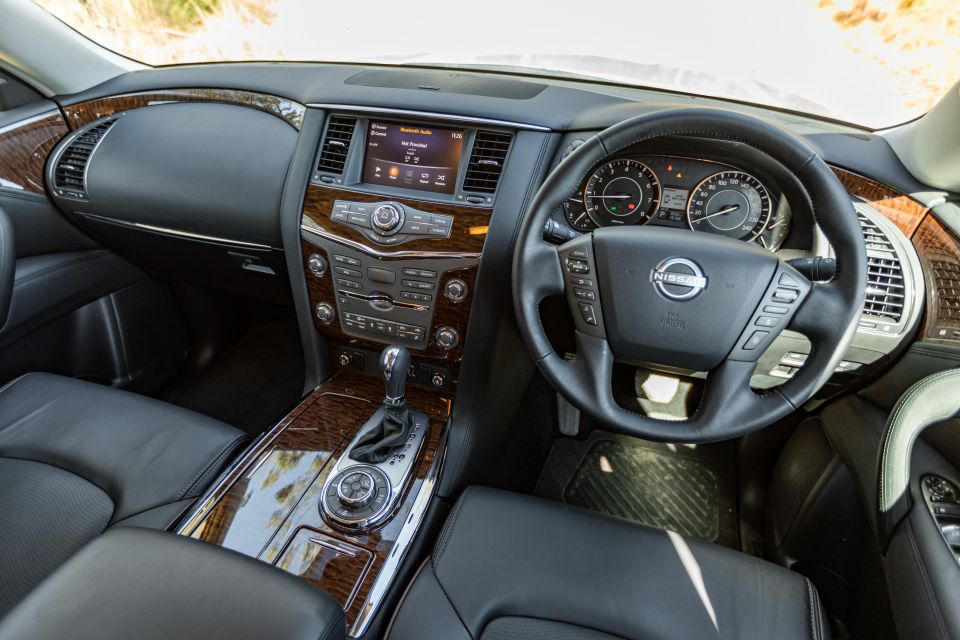
Standard equipment unique to the Patrol Ti-L includes:
Our Grand Cherokee L Summit Reserve didn’t include all of the Advanced Technology Group package’s features, with the front passenger touchscreen not present on the first Summit Reserves in Australia. All three other features were fitted, however: a head-up display, night vision, and a wireless charging pad.
Unusually, however, remote start isn’t offered despite this feature being available in the US.
While the Grand Cherokee L is a steep $20,000 or so more than the Patrol, there’s a stack of extra equipment that goes some way to justifying this.
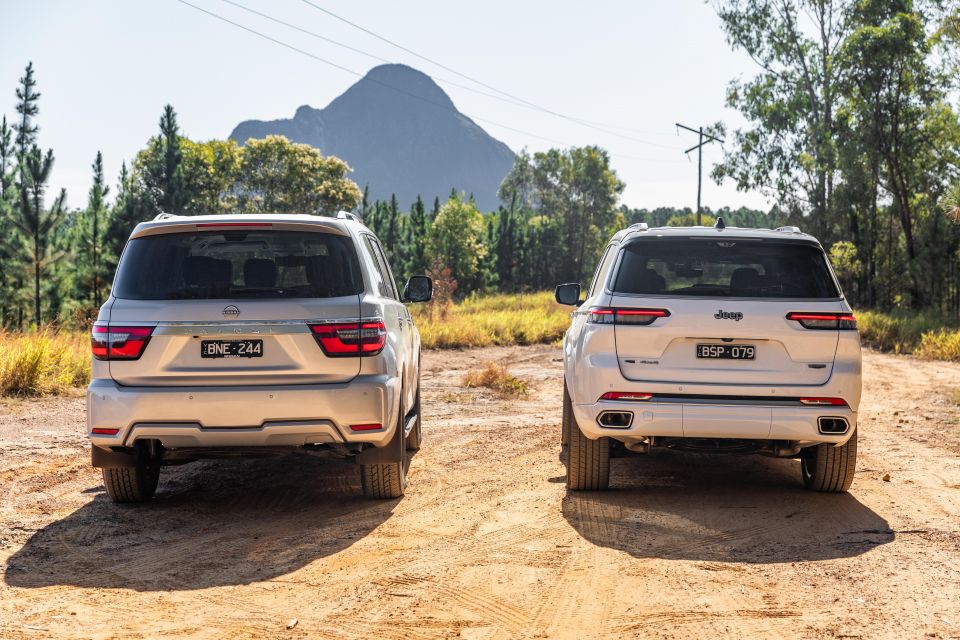
Neither vehicle has a safety rating from ANCAP. While that’s not particularly surprising for the Grand Cherokee L, which was only launched here this year, it’s disappointing for the Patrol as it’s been on sale since 2013 in Australia.
Safety equipment common to both vehicles includes:
The Patrol alone features:
The Grand Cherokee L alone features:
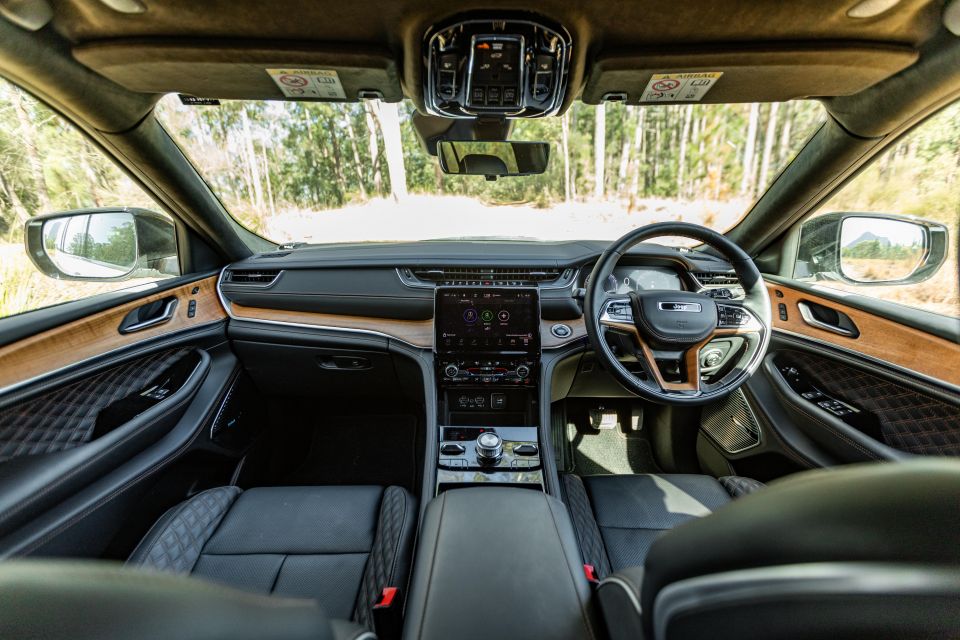
Grand Cherokee L
The Grand Cherokee L’s cabin looks gorgeous in Summit Reserve stitching, with its genuine open-pore wood trim and contrast stitching. The available Tupelo interior swaps the black leather upholstery out for a warm tan/brown if you’d like some more colour, while colour-adjustable ambient lighting adds to the atmosphere.
It doesn’t physically feel quite as convincing, at least not for a vehicle at this lofty price point. The sides of the centre console have stitching, but they feel like hard plastic. The quilted leather-look door inserts also feel thin and firm. At least the dash top has nice, soft-touch trim, but it feels like Jeep has cut some corners in the cabin.
The switchgear, fortunately, is nice and tactile. The stalks feel well-damped, the shifter dial feels solid, and the rocker switches for the climate control and air suspension are well-weighted.
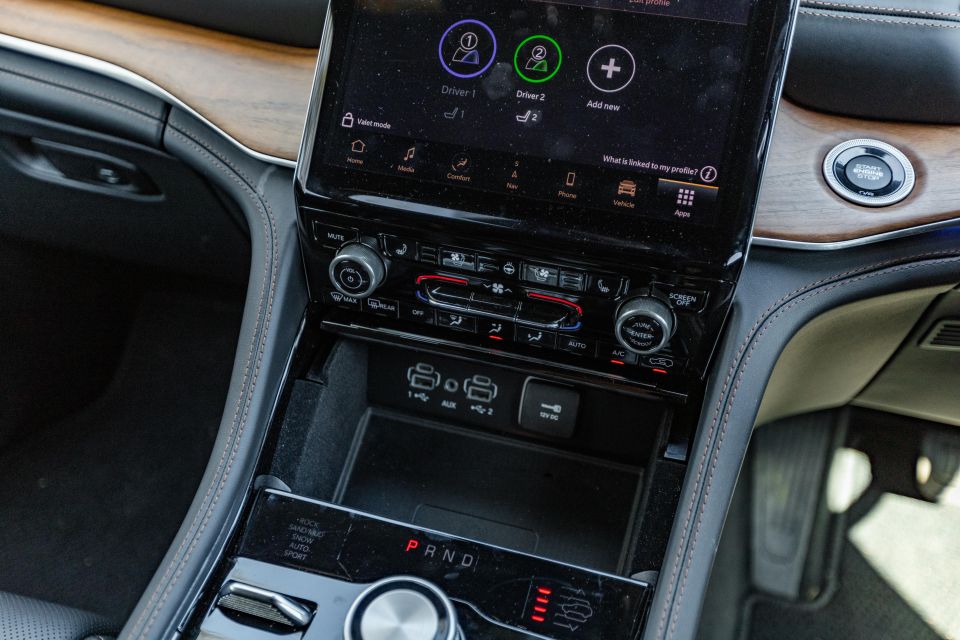
A pity, though, that so much of the dashboard and centre console is swathed in gloss black trim. It may look nice at first, but it’s a magnet for smudges and scratches.
The steering wheel is quite chunky and the front seats are firmer than the Patrol’s, though they feature thigh extenders for greater support. There’s also a massaging function for the seatback.
The Jeep runs on the latest UConnect 5 infotainment system, and has a larger 10.1-inch screen than the base Night Eagle’s 8.4-inch unit. There’s embedded satellite navigation, as well as wireless Android Auto and Apple CarPlay.

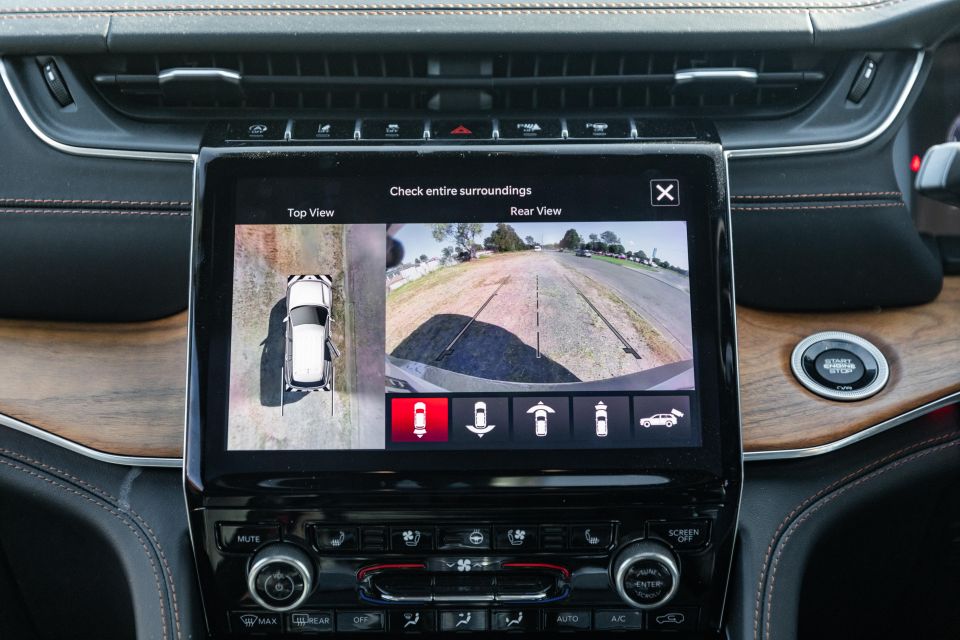
It’s a thoroughly modern interface, and there’s typically more than one way to access the various displays and apps. But as more than one person told me, the interface can look rather complicated, particularly the apps menu.
There are plenty of neat features, like the FamCam which shows a camera view of the second and third rows, and a button on the touchscreen that allows you to drop the third-row headrests.
The camera views are also considerably higher in resolution than those in the Patrol, though they can get a bit washed out by lights at night.
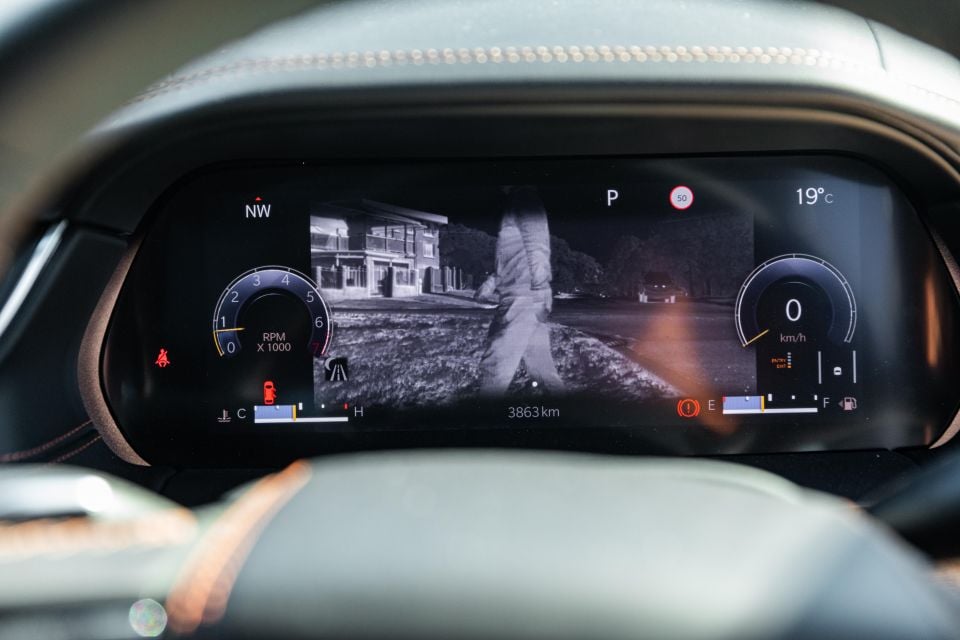
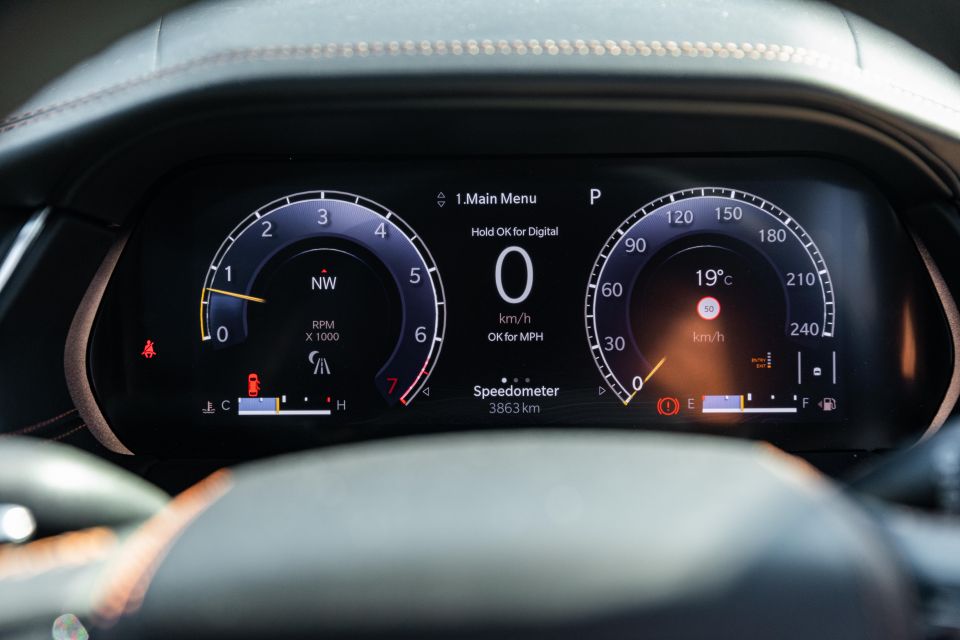
The instrument cluster is less intuitive, and requires a bit of scrolling up, down and across to access the different functions.
There’s plenty of adjustability, but you can simply specify a classic analogue-style gauge view. There’s also a map view, though it’s not quite as detailed as the Volkswagen Touareg and Audi Q7’s Virtual Cockpit set-up.
The Grand Cherokee L does have a feature most rivals can’t offer: Night Vision, which takes over almost the entire cluster. It’s handy, too – it activated automatically one night when a pedestrian almost stepped in front of my car.
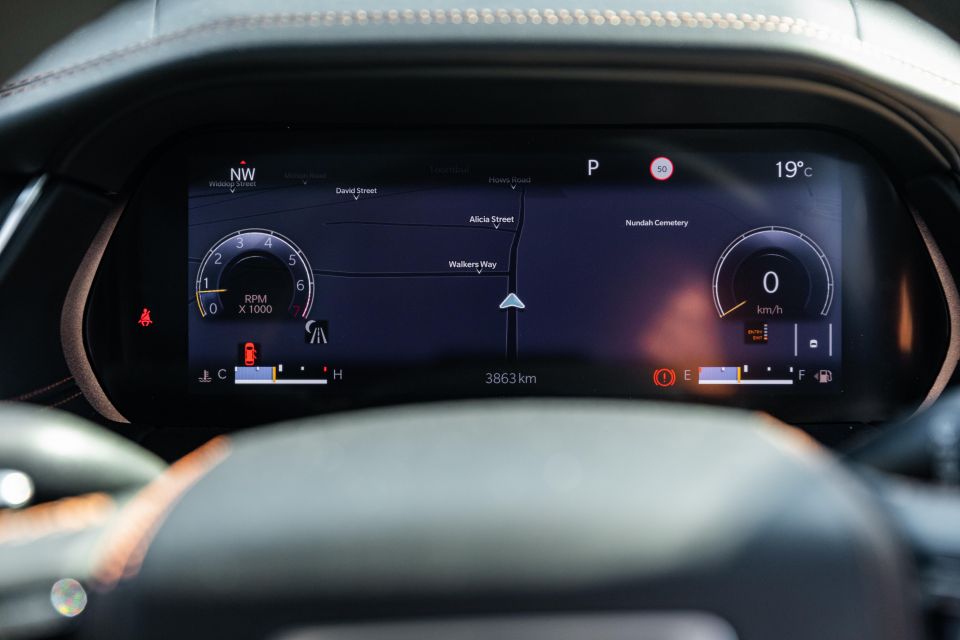

The technology is miles ahead of the Nissan’s, and the amount of gadgets and features is impressive even at this price point. But we can’t give the Jeep a perfect 10 in this category, as its software had a number of annoying bugs we hope will be resolved in over-the-air updates.
The instrument cluster’s map display, for example, froze in one location one day and didn’t fix itself upon start-up. This meant I effectively couldn’t use navigation, as it thought I was still miles away from my actual location. This issue fixed itself overnight.
On the touchscreen, Android Auto also refused to activate night mode. This also fixed itself overnight, and this wasn’t because of any software update as the car wasn’t connected to wi-fi.
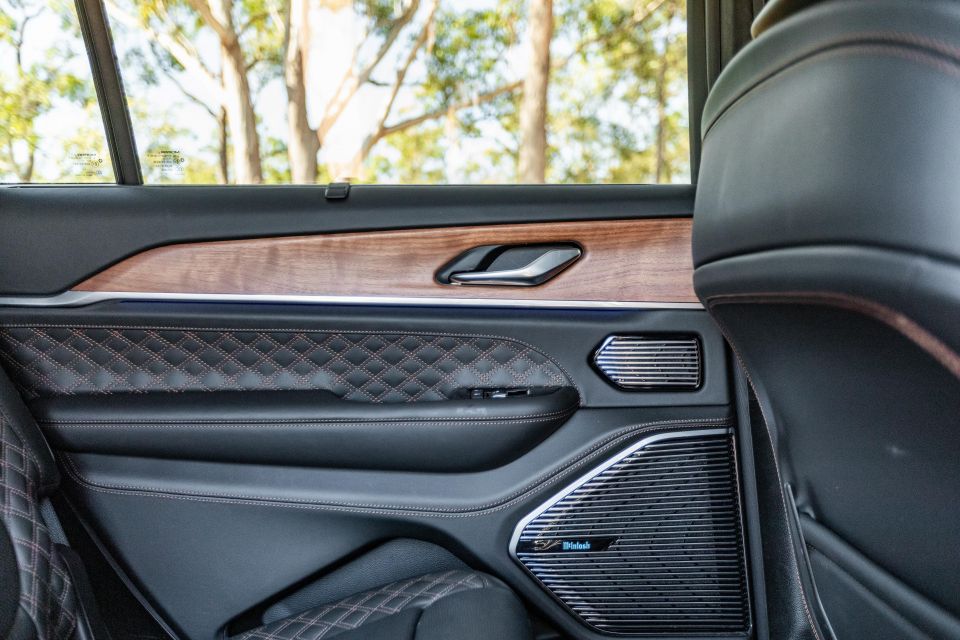
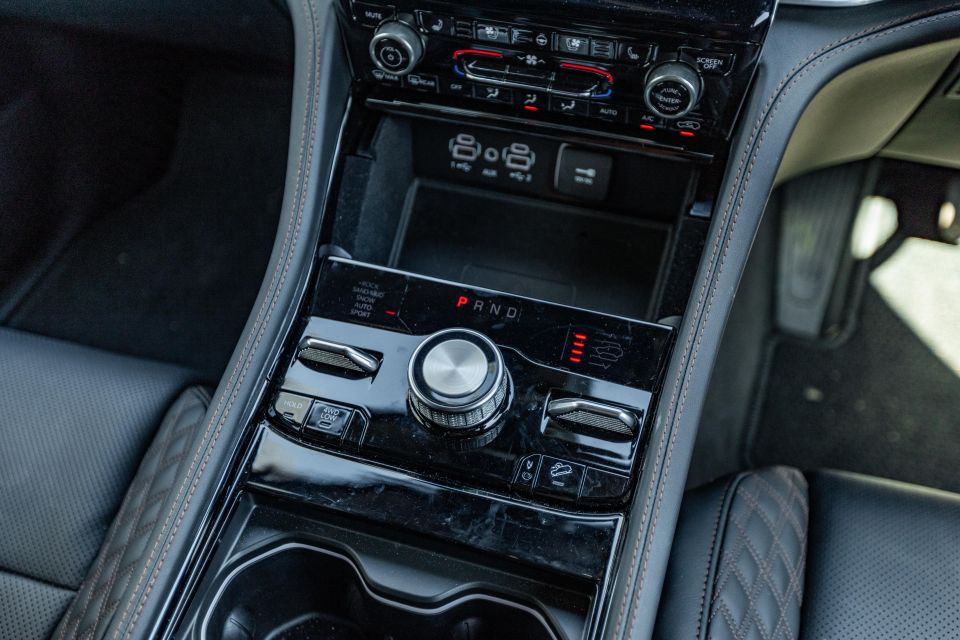
On another occasion, I had Android Auto connected wirelessly, but while driving a passenger with a Samsung Galaxy I repeatedly received a prompt on the screen asking if I wanted to end my Android Auto session and connect their phone. Regardless of whether I pressed ‘No’ or the X button, this prompt kept intermittently appearing.
It’s almost amusing – the Jeep is so eager for its occupants to use Android Auto, while the Nissan doesn’t offer it at all.
We’ve spoken before about our Melbourne tester and a couple of its build quality issues, including loose-feeling steering wheel controls. Well, our Brisbane tester had some issues of its own beyond the aforementioned software bugs.
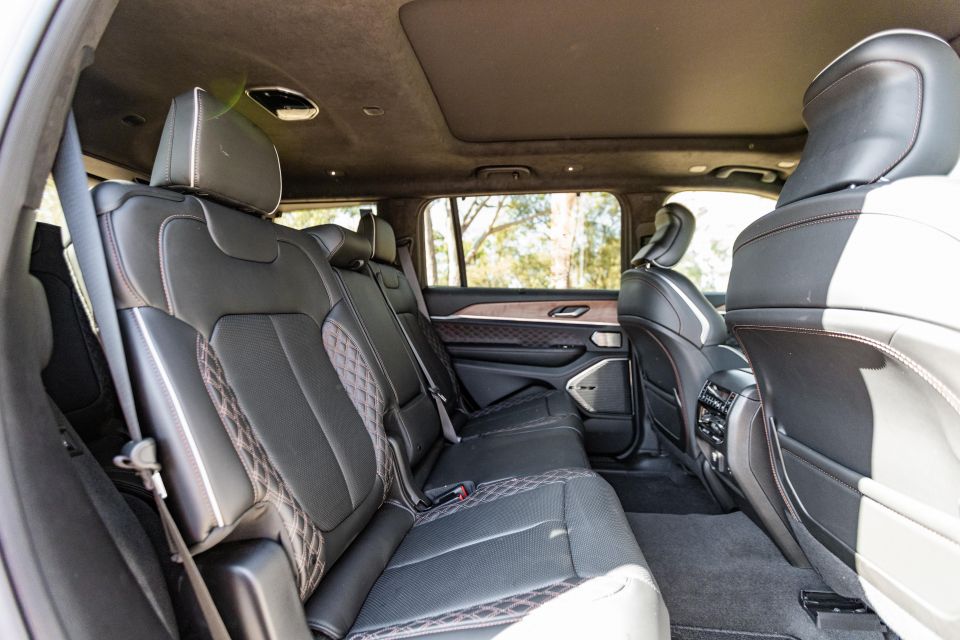
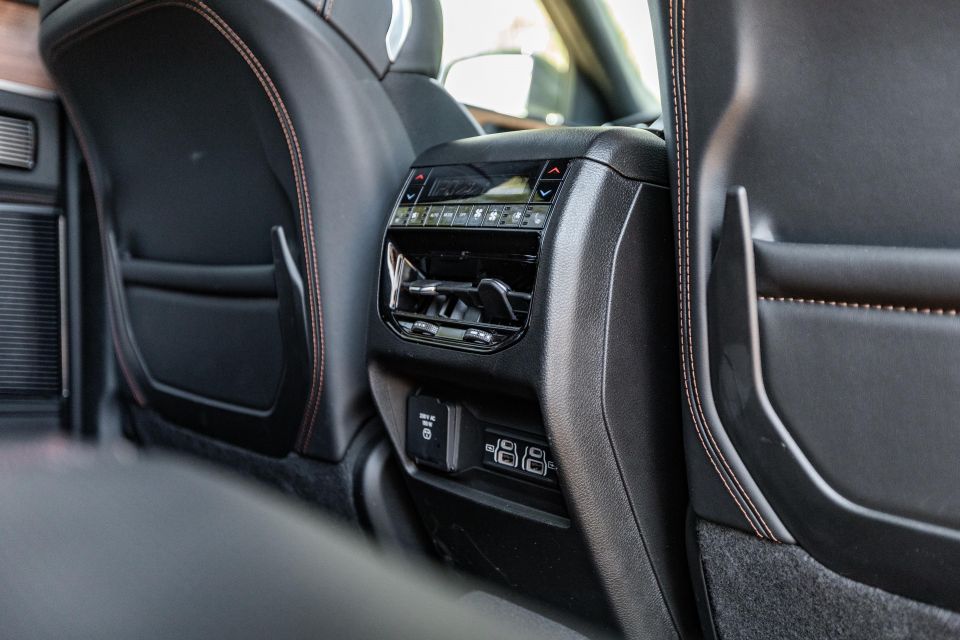
Where expert car reviews meet expert car buying – CarExpert gives you trusted advice, personalised service and real savings on your next new car.
The air-conditioning was noisy under even its lowest fan setting, and the air seemed to be flowing out of one vent more than the others. The driver’s door also had a faint creak coming from it.
The second row of seating isn’t quite as palatial as in the Patrol, but the outboard seats are both heated and ventilated like those up front. The panoramic sunroof also reaches back quite far, and does so without eating into headroom too much.
There are two USB-A outlets and two USB-C outlets, plus climate controls and a 230V outlet.
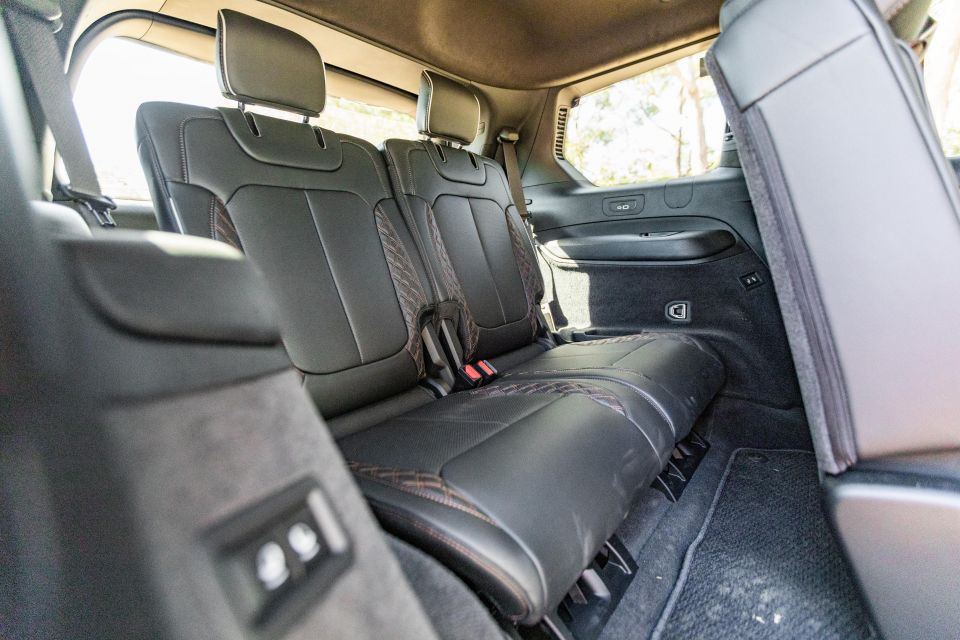
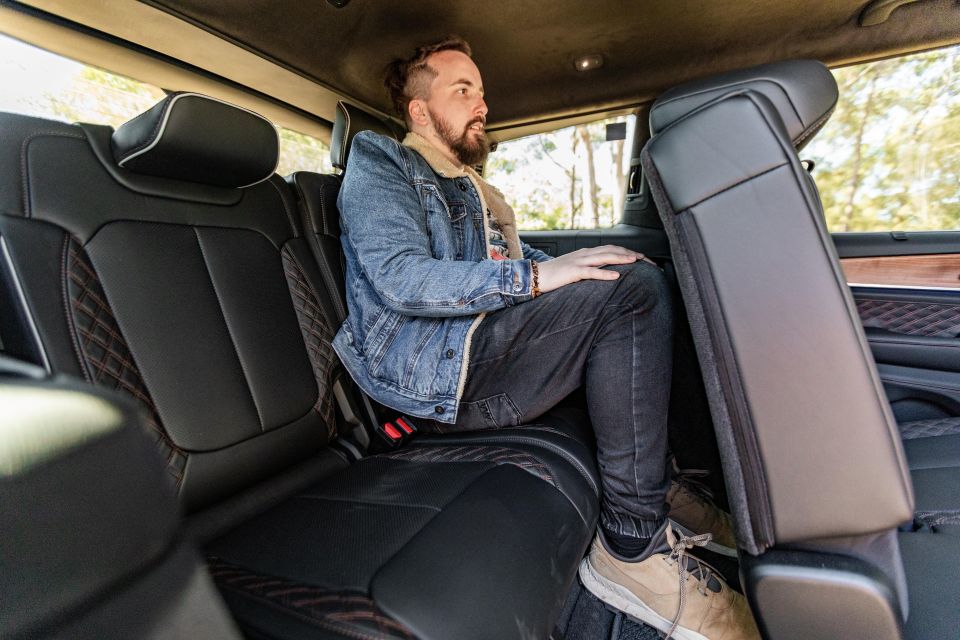
Access to the third row is easy, as with a single pull of one of the second-row seats, it lifts off its base and tilts forward.
It’s genuinely comfortable back there for most adults. At 180cm tall, I had sufficient headroom and plenty of knee room.
There are more amenities back here than the Patrol, too, with USB-A and USB-C outlets on each side, plus air vents in the pillars and a cupholder on each side.

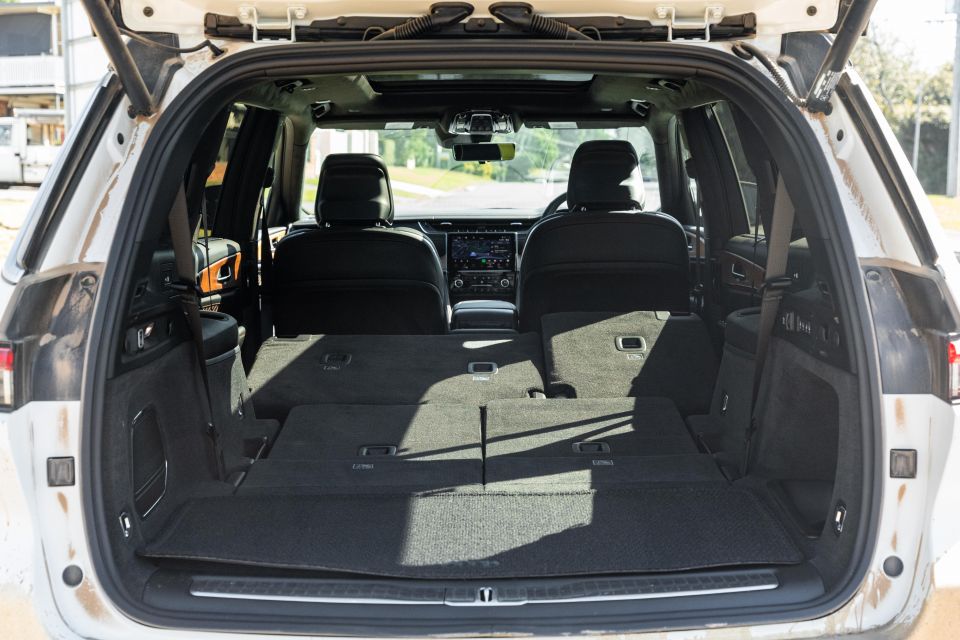
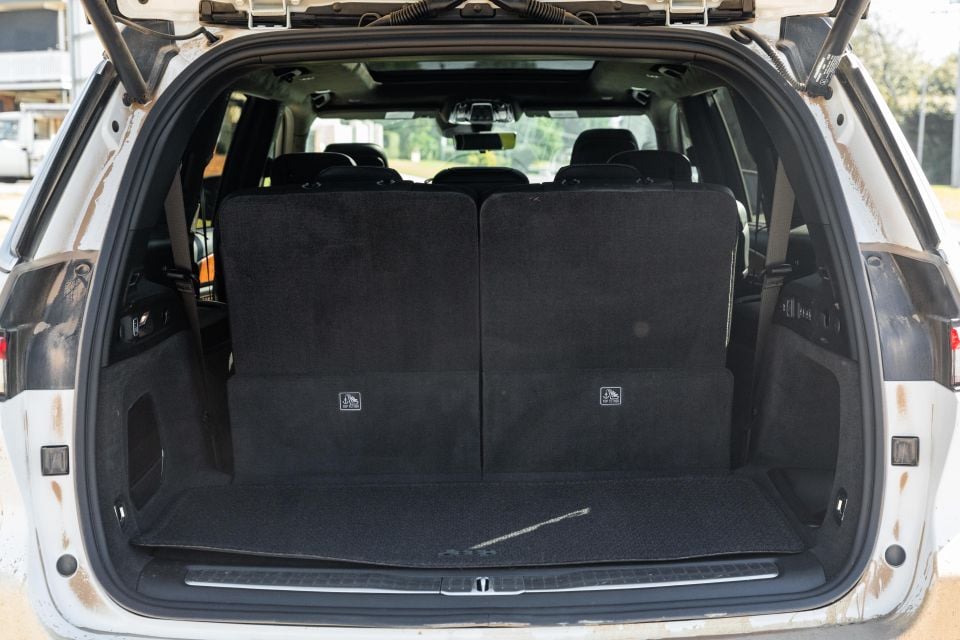
Despite these comfortable third-row accommodations, there’s actually a surprising amount of boot space for a three-row SUV. Cargo space measures 487L, expanding to 1328L with the third row dropped and 2395L with the second row folded as well.
There are power-folding second and third rows, though only the third row will return to its upright position with the press of a button.
Jeep has overall struck a good balance between cargo and passenger space, and made good use of the Grand Cherokee L’s length.
We appreciate some of the thoughtful details on the Grand Cherokee, like LED lights on the exterior door handles and back-lit switches inside the cabin.
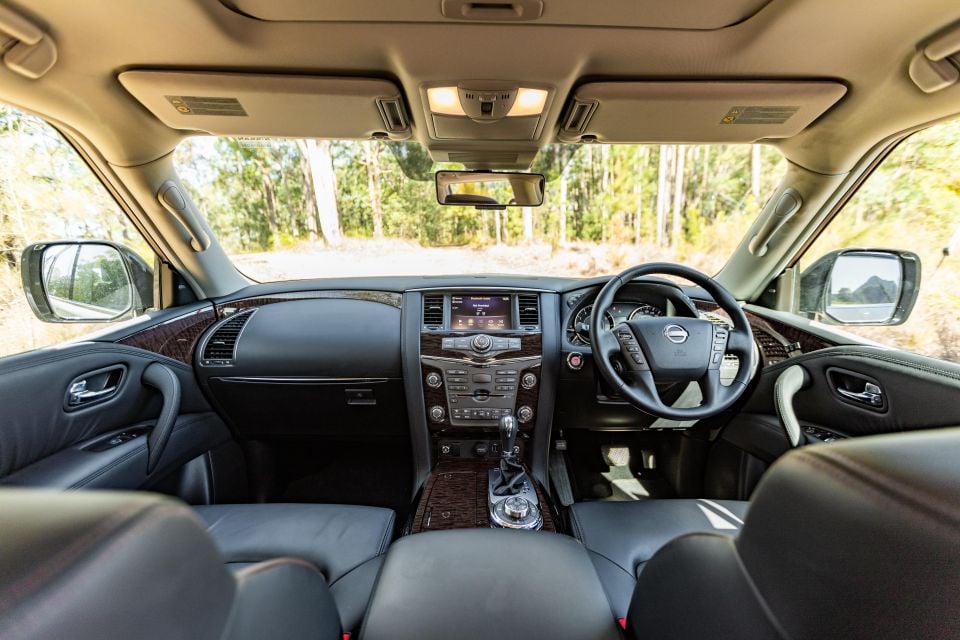
Patrol
Talk about a throwback.
The Patrol’s cabin is swathed in unconvincing woodgrain trim, with door trims finished in gathered leather. Both trim choices make the interior look even older than 2011.
The centre stack is a sea of buttons, in mid-2000s Nissan and Infiniti fashion. There’s still a CD player, but its pride of place on the dashboard harkens back to the days when a 6-CD stacker was the height of luxury.
The old-school Nissan design has its advantages. The parts-bin heated and ventilated seat controls are tactile and remember your setting when you turn the car off, and there are physical climate controls – a relief, because the less we have to use that touchscreen, the better.
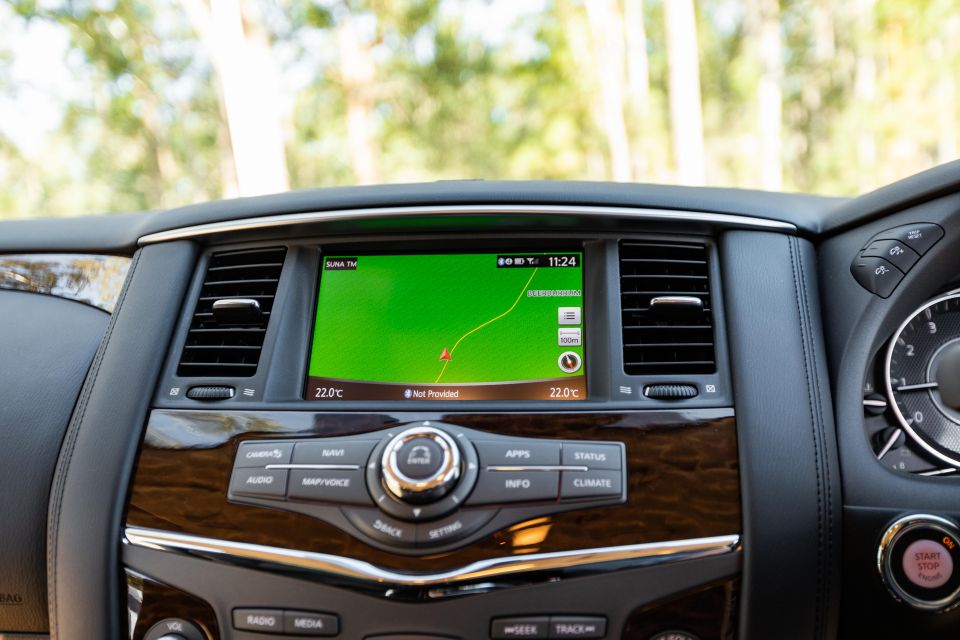
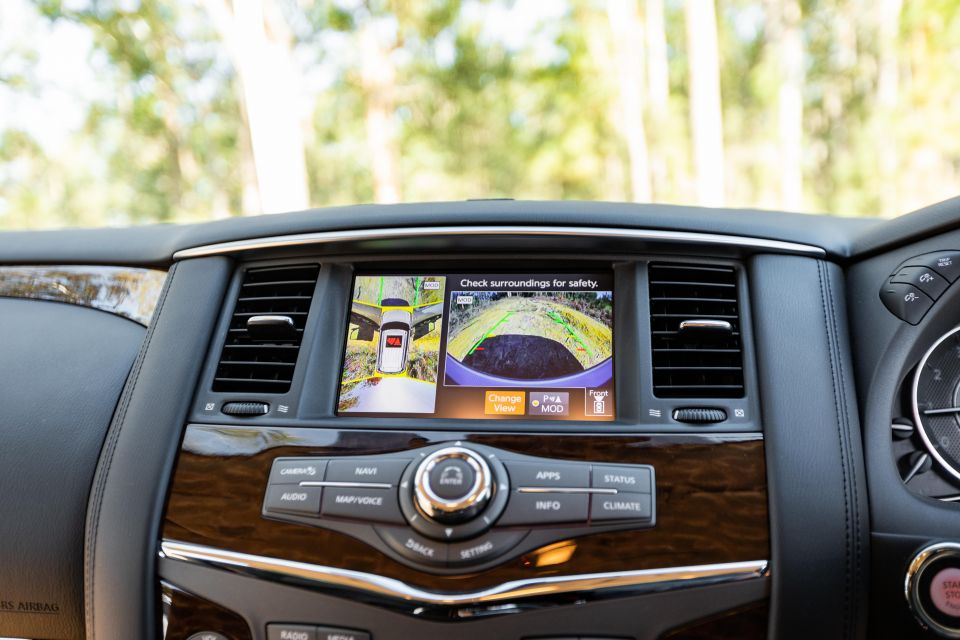
Camera quality is utterly disappointing for a vehicle at this price point, though it’s not the absolute worst I’ve seen. There’s a surround-view camera, which means there are four separate cameras – handy when you’re off-roading. These individual cameras do require a couple of button presses to activate, however.
There’s no smartphone mirroring, forcing you to use the dated factory navigation system. I’ve seen Refidexes that look better. You have to type in addresses too, as the voice prompts don’t work for navigation, only for phone, audio or vehicle info.
There’s no home screen, per se, but you can press the unusually named Status button to view a summary of audio and climate information.
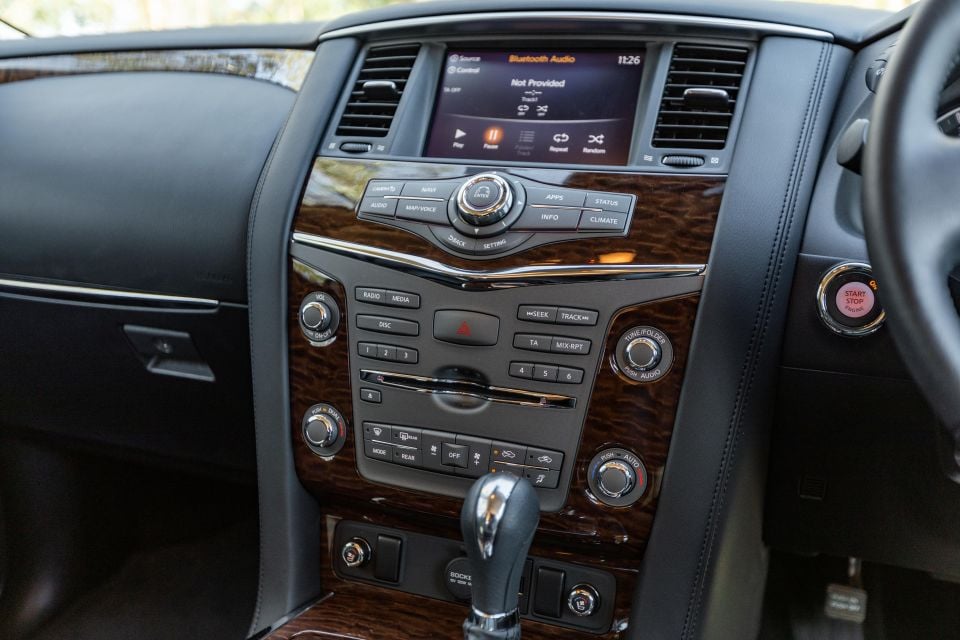
There’s also a menu called Apps, which features an array of screens that might just be the slowest I’ve ever experienced in a late-model vehicle.
Said apps include a compass, clock, something called an App Garage, and a driving performance screen that shows you your fuel flow and the way your steering is centred. All have extremely dated graphics.
There’s also an Info screen that displays your fuel economy, tyre pressures, and maintenance information.
All of this information needs to be accessed via the touchscreen because the instrument cluster screen is a dated little dot-matrix display.
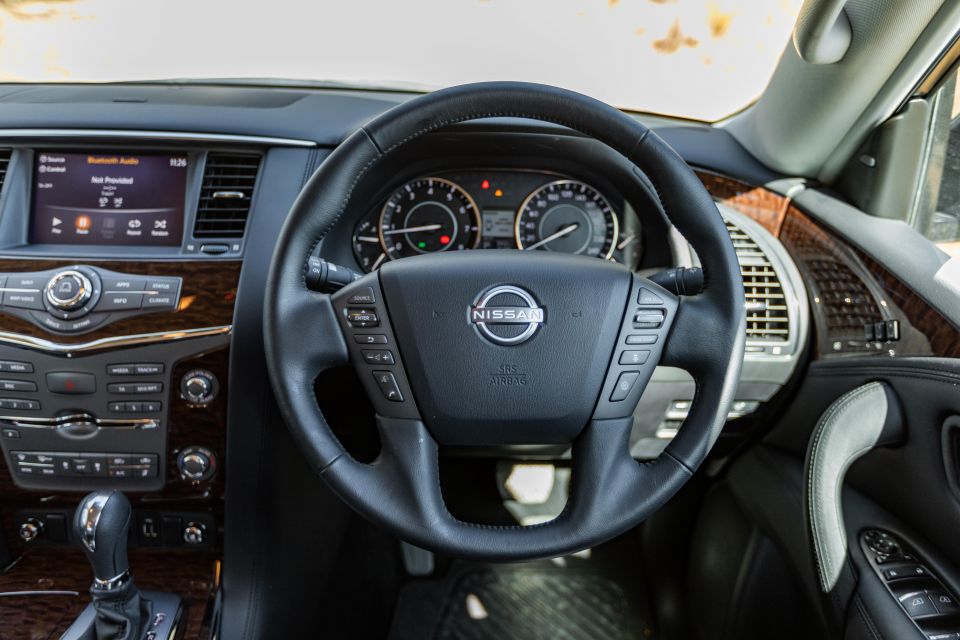
There’s no digital speedometer, its most egregious failing, while the pictogram of the car doesn’t even look like a car. It looks like a Tamagotchi screen, but at least it’s flanked by a pair of elegant analogue dials.
The front seats are plush, but the seat base is too short and there’s very little bolstering. The Grand Cherokee’s seats may be firmer but they’re more supportive.
The outsized dimensions of the Patrol and the low centre console means you never feel hemmed in when sitting up front. Your knees may never touch the side of the centre console but, should they do so, they’ll rest against soft-touch trim.
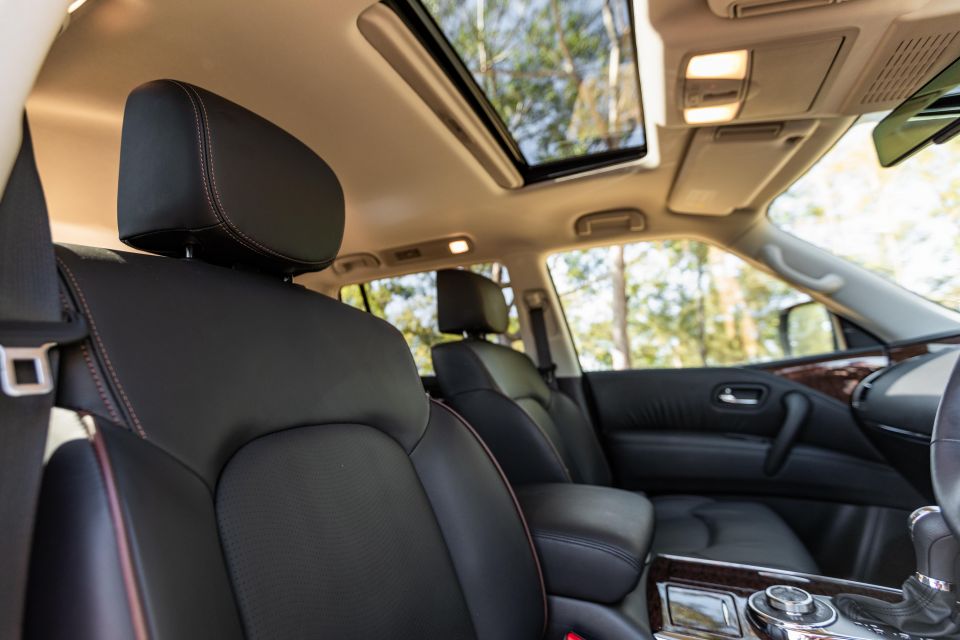
Storage is subpar. I seem to recall we did in fact have mobile phones in 2011, but Nissan didn’t design a decent place to put one if you’re charging it – there’s no shelf at the base of the centre stack, leaving you to put it in a cupholder or secrete it away in the centre console bin.
Where the Patrol edges ahead of the newer Jeep is in build and material quality.
We experienced no build quality issues, while seemingly every surface is finished in either soft-touch plastic, leather or leatherette trim. That gathered leather on the doors might look more 1990s Maxima than the Grand Cherokee’s diamond-quilted stuff, but the Patrol’s trim is a lot more convincing to the touch.
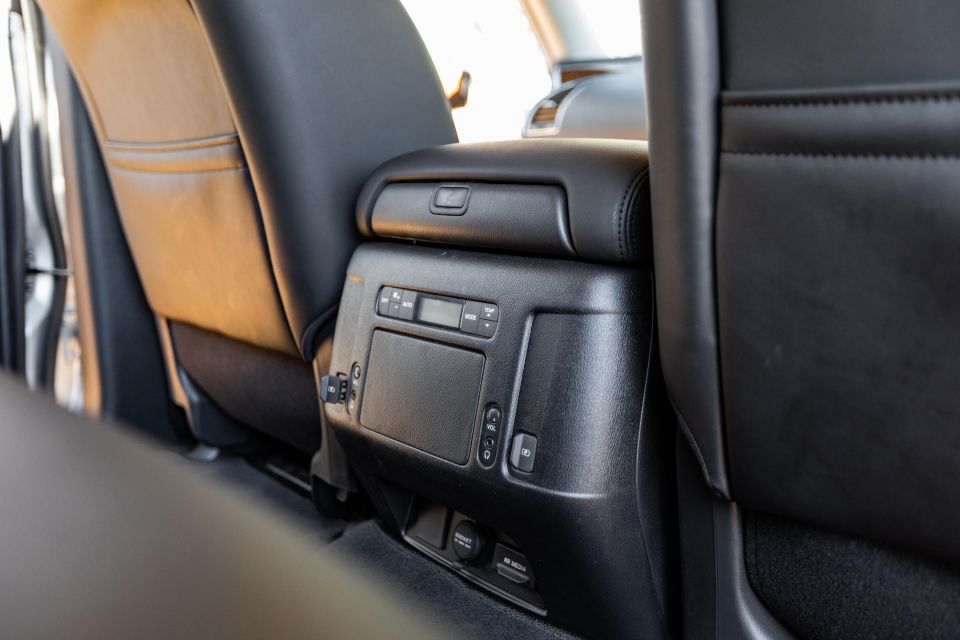
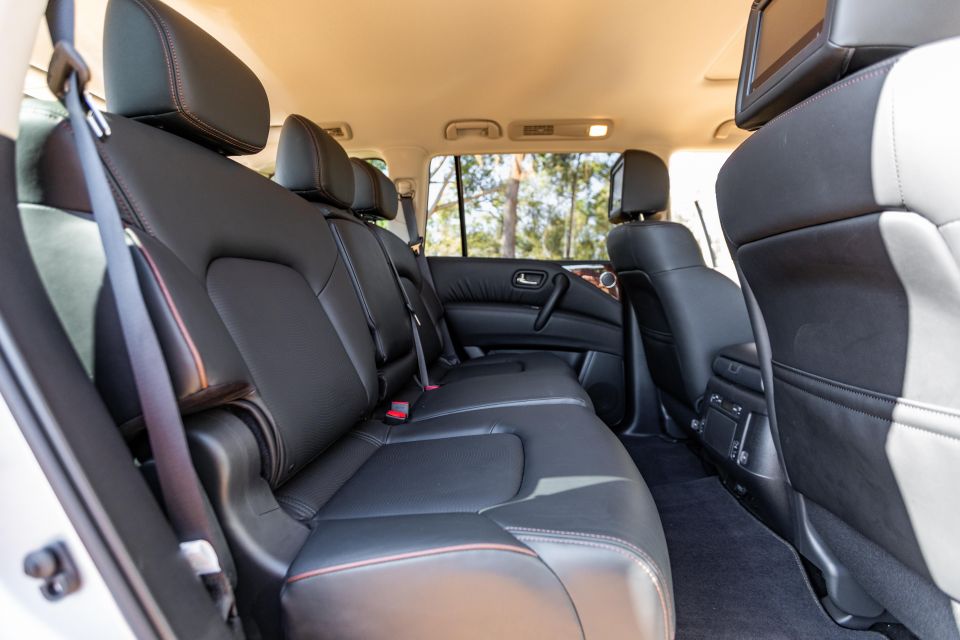
Only the absolute bottom of the doors and dash, plus the glove compartment lid, are finished in hard plastic.
Step into the second row and there’s plenty of space in every direction and a cushy, comfortable bench seat. The driveline hump is also quite low, making for a relatively flat floor.
There are plenty of amenities, too. Each front-row headrest has an 8.0-inch screen in the back for watching movies, while there’s a pair of USB-A outlets, headphone jacks, a 12V outlet, and climate controls.
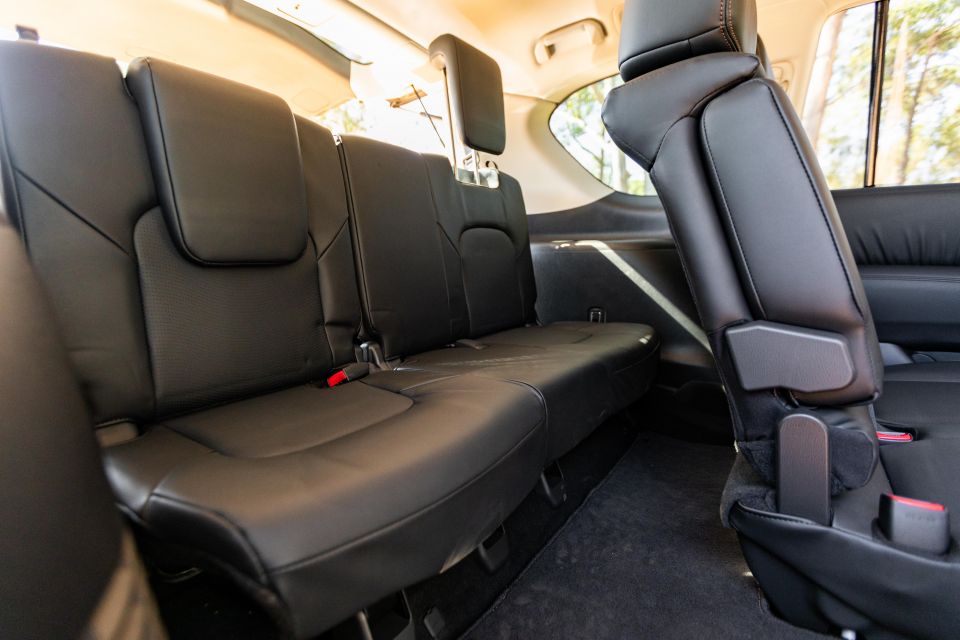
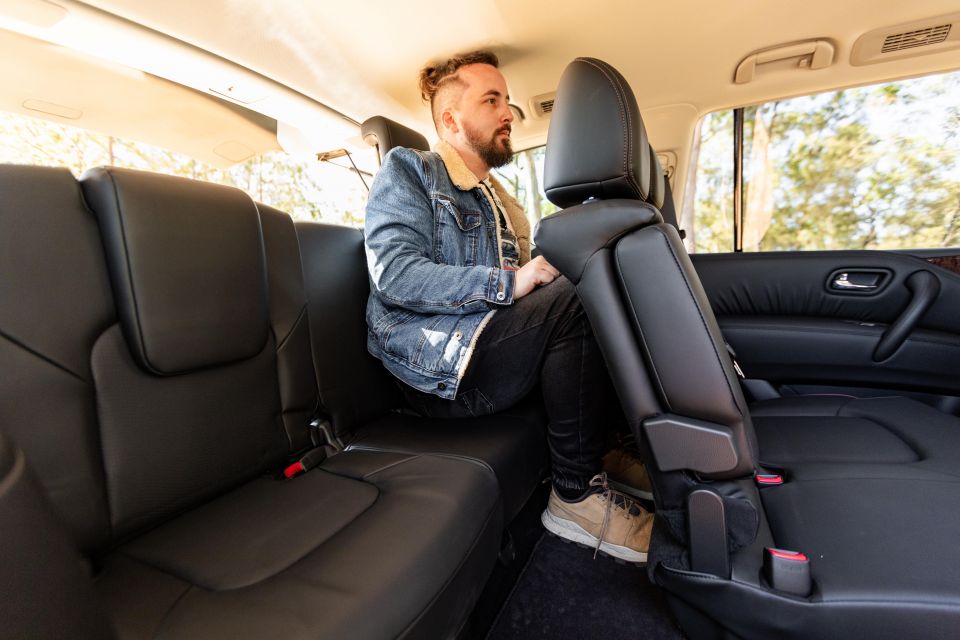
The front centre console bin can also be opened from the second row.
Access to the third row is a cinch – pull one lever and the seat flips forward almost instantaneously. The opening also appears larger than the Jeep’s, making it easier to access the rearmost seats.
It’s not as comfortable as the Grand Cherokee L back here. I measure 180cm tall, and my head was touching the roof while my knees were up against the second-row seatbacks. But toe room is decent, while shoulder room is excellent – after all, this is a three-seat bench in the Ti.
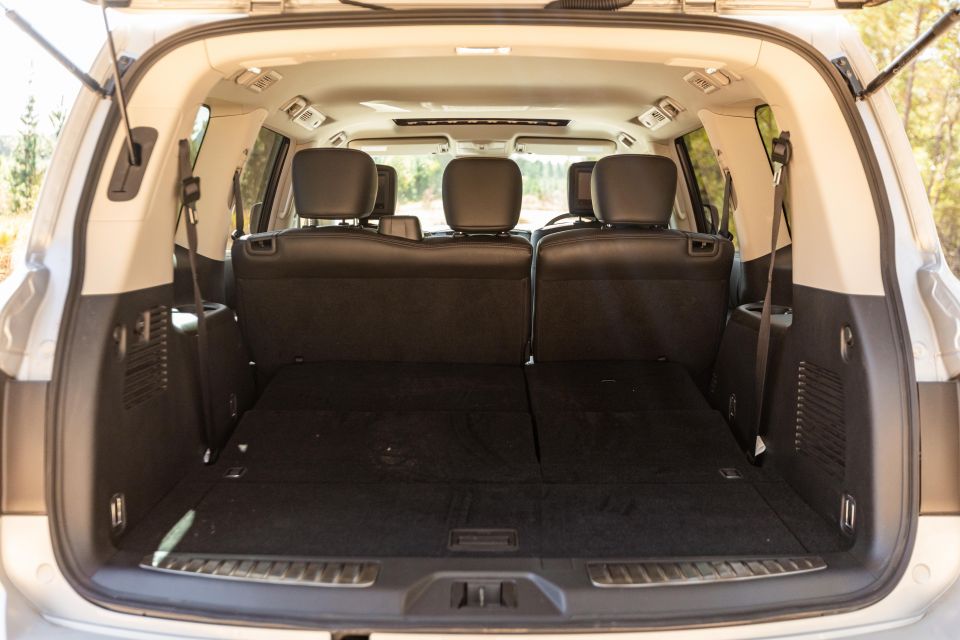
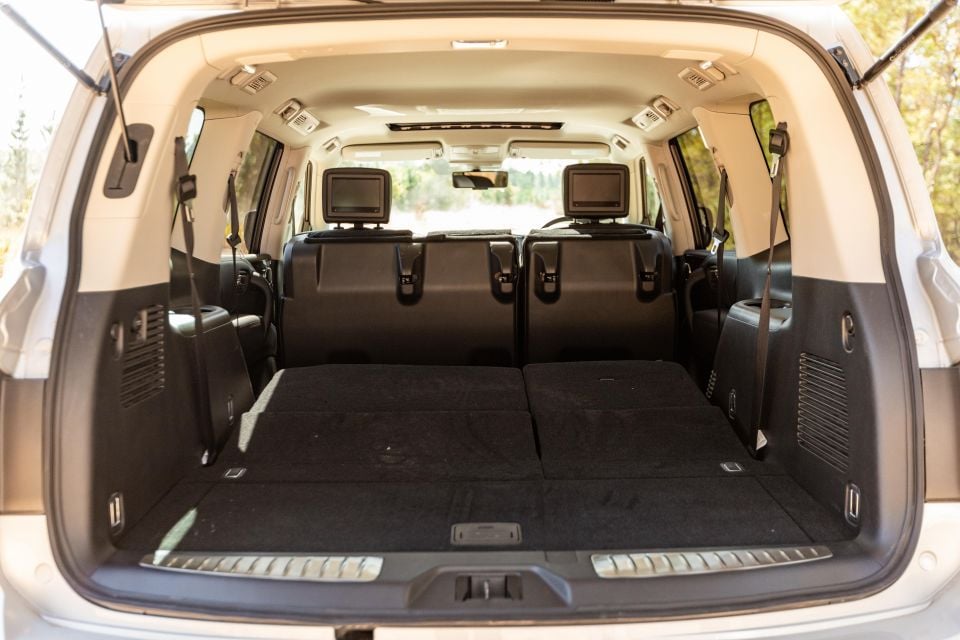
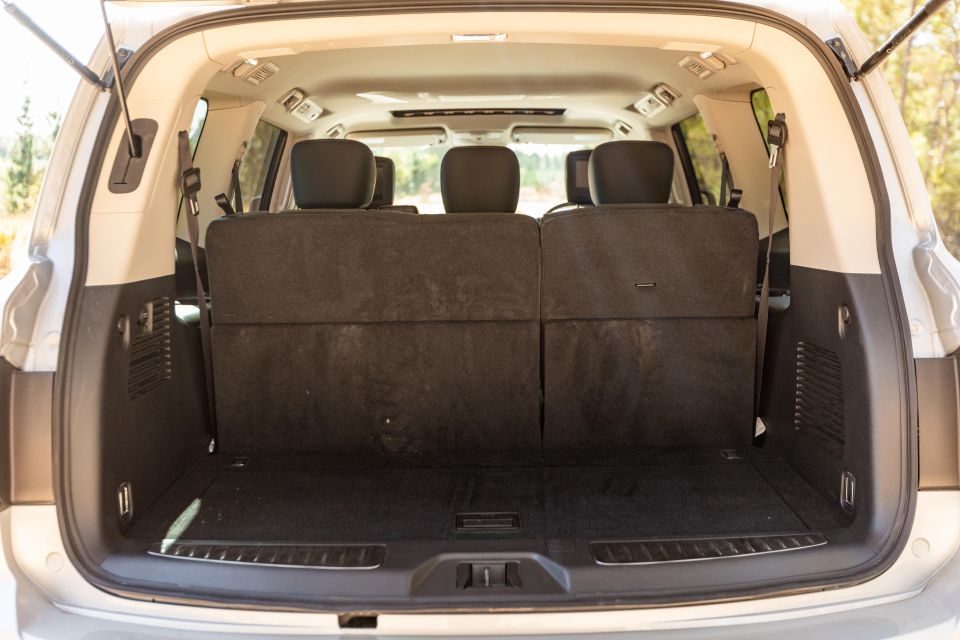
Adults my height or shorter will find it comfortable enough for shorter trips, but it’s best suited for kids.
There are four cupholders back here, plus a 12V outlet and air vents on the roof.
The Patrol has a slight edge over the Grand Cherokee L in terms of cargo capacity. There’s 467L of boot space with the third row up, expanding to 1413L with it folded. With both the second and third rows folded, there’s 2623L.
| Grand Cherokee L | Patrol | |
|---|---|---|
| Length | 5204mm | 5175mm |
| Width | 2149mm | 1995mm |
| Height | 1817mm | 1955mm |
| Wheelbase | 3091mm | 3075mm |
| Boot space | 487/1328/2395L | 467/1413/2623L |
| Spare wheel | 18-inch steel spare | Full-sized alloy spare |
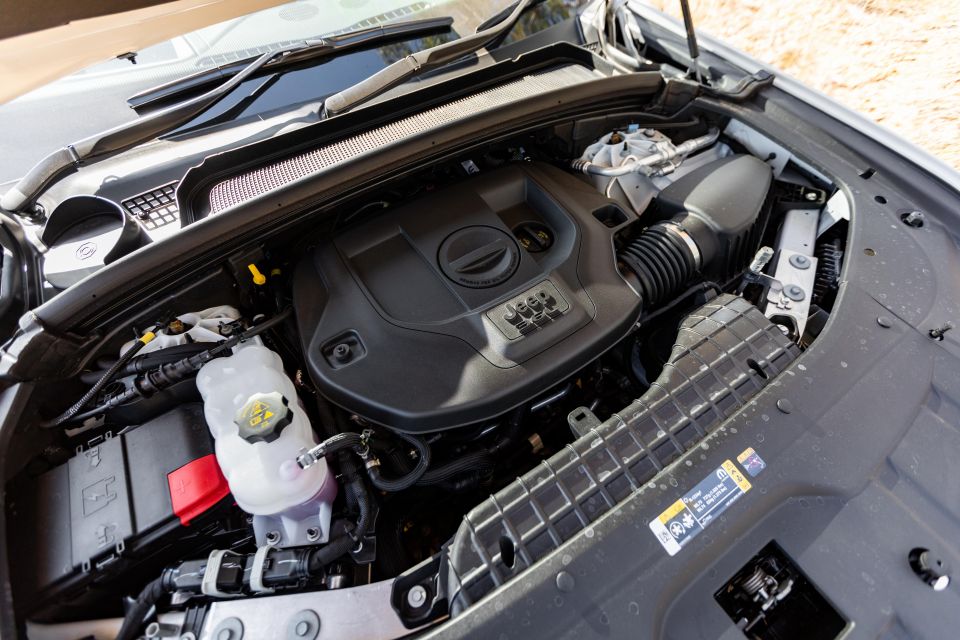
Grand Cherokee L
The only engine available in the Australian-market Grand Cherokee L is a naturally-aspirated 3.6-litre petrol V6 producing 210kW of power at 6400rpm and 344Nm of torque at 4000rpm. It’s mated with an eight-speed automatic transmission.
While it has roughly 500kg less to haul around than the Patrol, it’s down considerably in both power and torque. Sadly, the 266kW/530Nm 5.7-litre Hemi petrol V8 offered in North America isn’t offered here, while the old turbo-diesel V6 is dead globally.
The Summit Reserve features Jeep’s Quadra-Drive II 4×4 system, which features a two-speed active transfer case with low-range gearing instead of the single-speed case of lesser Grand Cherokee Ls. It also features Quadra-Lift air suspension.
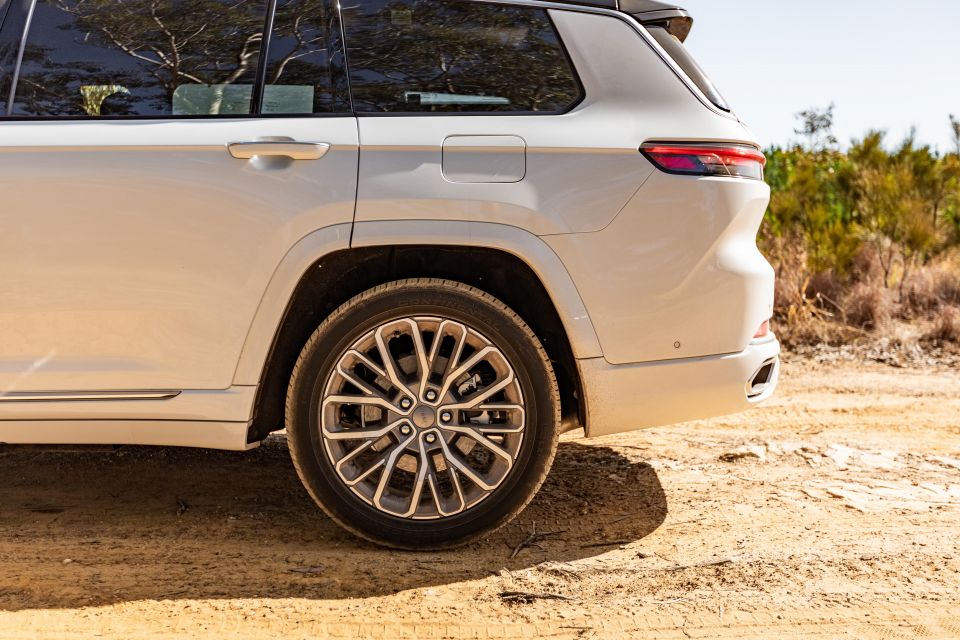
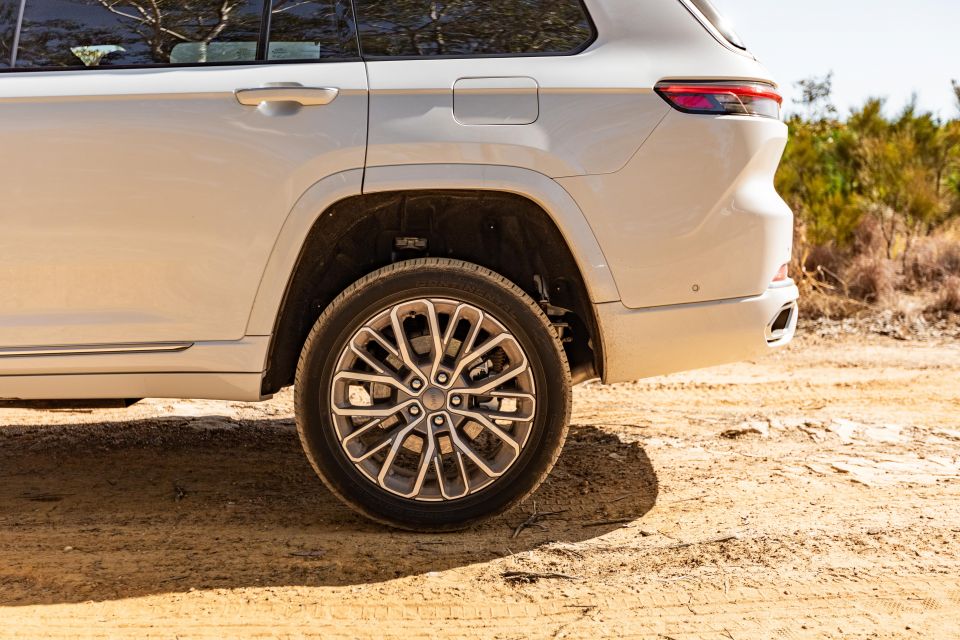
The Grand Cherokee L has a meagre 2268kg braked towing capacity in Summit Reserve guise, less even than the 2813kg of lower-spec models.
The Jeep bests the Patrol in ground clearance, but only if you put it in Off-Road 2 mode. Adjusted accordingly, it has 276mm of clearance against 273mm in the Patrol.
Likewise, in said mode the Grand Cherokee L has an approach angle of 28.2 degrees, a departure angle of 23.6 degrees, a breakover angle of 22.6 degrees, and wading depth of 610mm.
Over a mix of inner-city, suburban and highway driving, we averaged 12L/100km. This increased to 14.5L/100km during the working week, and dropped back down to 13.1L/100km after a weekend in the country. The official combined cycle rating is 10.6L/100km.
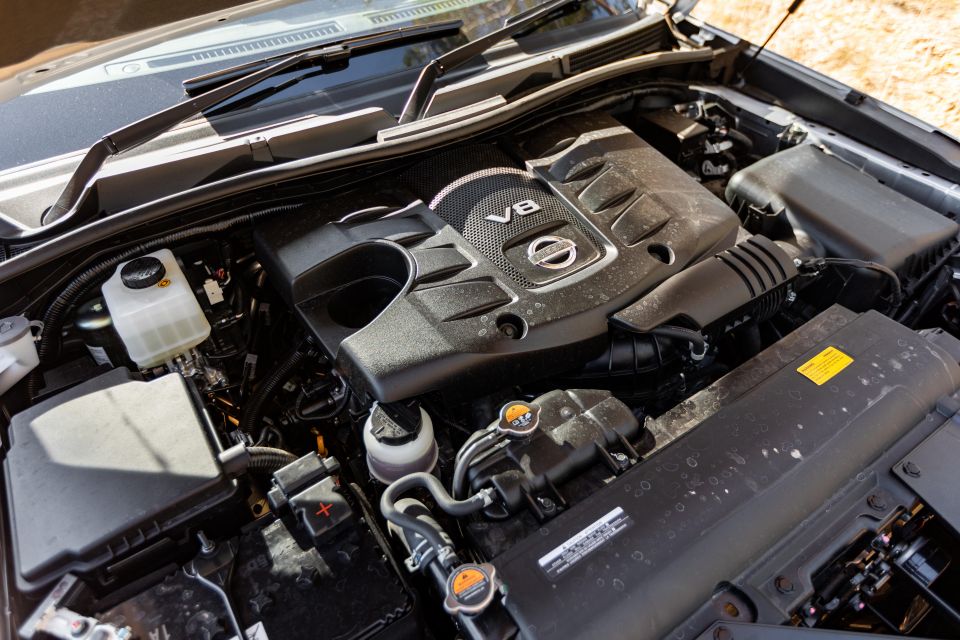
Patrol
The only engine available in the Patrol is a naturally-aspirated 5.6-litre petrol V8 producing 298kW of power at 5800rpm and 560Nm of torque at 4000rpm. It’s mated with a seven-speed automatic transmission.
If you’re planning on towing anything heavy, the Patrol is the obvious choice with its braked towing capacity of 3500kg.
The Patrol has 273mm of ground clearance, an approach angle of 28 degrees and a departure angle of 26.3 degrees. Nissan doesn’t specify the breakover angle or wading depth.
Over the same fuel economy route as the Grand Cherokee L, we averaged 14.2L/100km though over the course of a week, the Patrol seemed to hover around 16.6L/100km. The official combined cycle claim is 14.4L/100km.
| Grand Cherokee L | Patrol | |
|---|---|---|
| Engine | 3.6-litre petrol V6 | 5.6-litre petrol V8 |
| Fuel type | 91 RON regular unleaded | 95 RON premium unleaded |
| Power | 210kW at 6400rpm | 298kW at 5800rpm |
| Torque | 344Nm at 4000rpm | 560Nm at 4000rpm |
| Transmission | Eight-speed automatic | Seven-speed automatic |
| Drive type | Full-time four-wheel drive | Full-time four-wheel drive |
| Tare weight | 2270kg | 2750kg |
| Towing capacity | 2268kg braked | 3500kg braked |
| 0-100km/h (as tested) | 8.2 seconds | 6.48 seconds |
| Combined fuel economy (claimed) | 10.6L/100km | 14.4L/100km |
| Fuel economy (observed) | 12L/100km | 14.2L/100km |
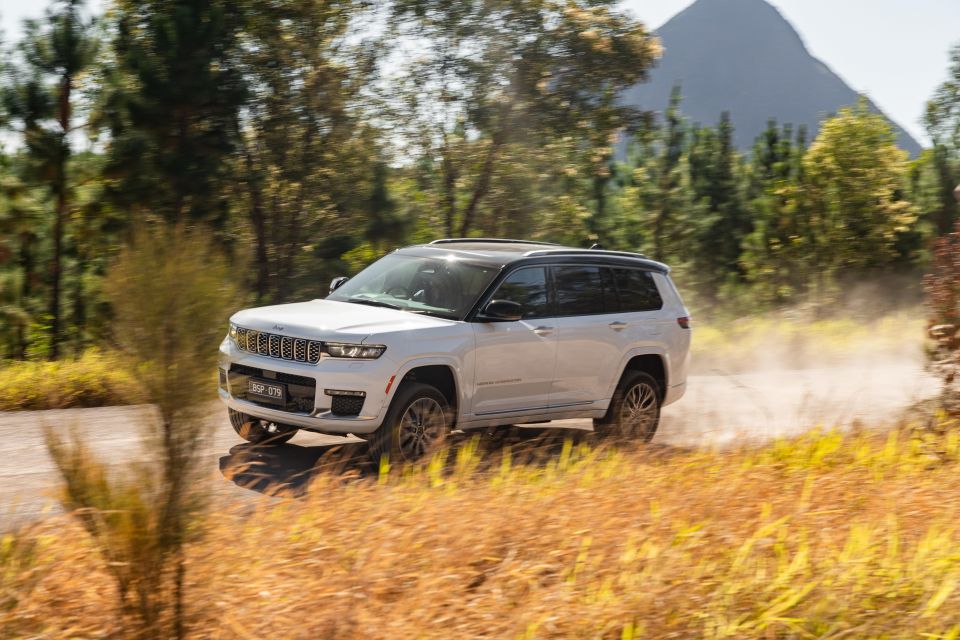
Grand Cherokee L
At this price point, there are some SUVs to be had with some genuinely good engines: not only the Patrol’s V8, but also the torquey turbo-diesel sixes found in everything from the LandCruiser 300 Series to the Land Rover Discovery, Genesis GV80 and Volkswagen Touareg.
That makes it all the more disappointing the Jeep uses the venerable Pentastar V6, the same engine that’s seen duty in vehicles like the Dodge Journey and Jeep Wrangler since its launch just over a decade ago.
It doesn’t have the pull of the defunct turbo-diesel V6 or the aural charm of the Hemi V8.
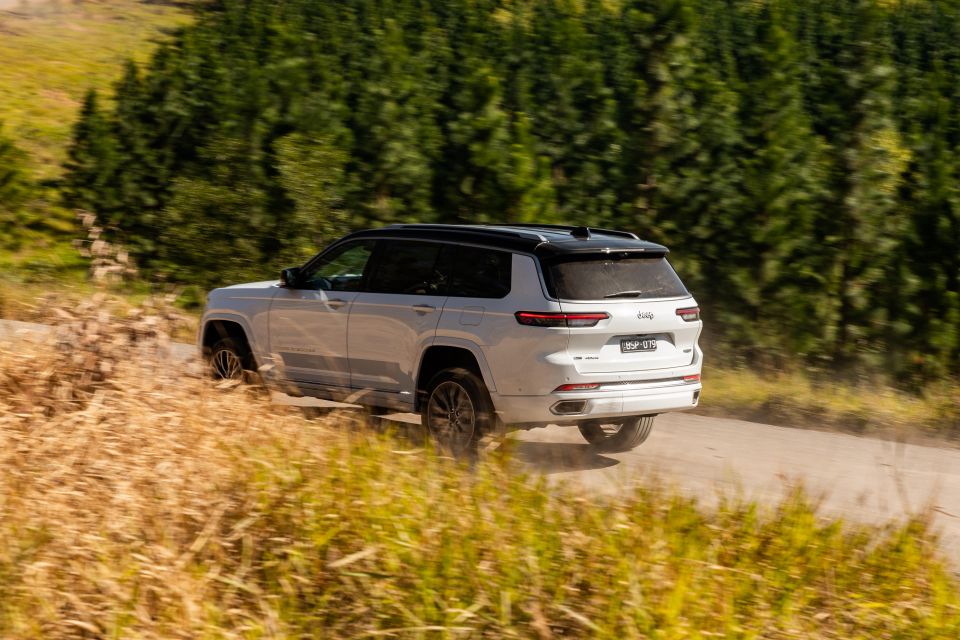
There’s this seemingly amplified, raspy engine note which seems intentional on Jeep’s part – American automakers have been known to exaggerate the sound of an engine or exhaust to make a vehicle sound sportier. It has the opposite effect here, as it makes it sound like the Jeep is working harder.
Lay off the throttle a bit and the cabin is fairly quiet, including at highway speeds. The transmission is also a smooth-shifting unit, while the automatic stop/start system engages unintrusively.
The Grand Cherokee L doesn’t feel dramatically underpowered, mind you, and it gets up to speed relatively authoritatively. The 0-100km/h time Paul Maric recorded of 8.2 seconds is acceptable, but this 2270kg SUV deserves better.
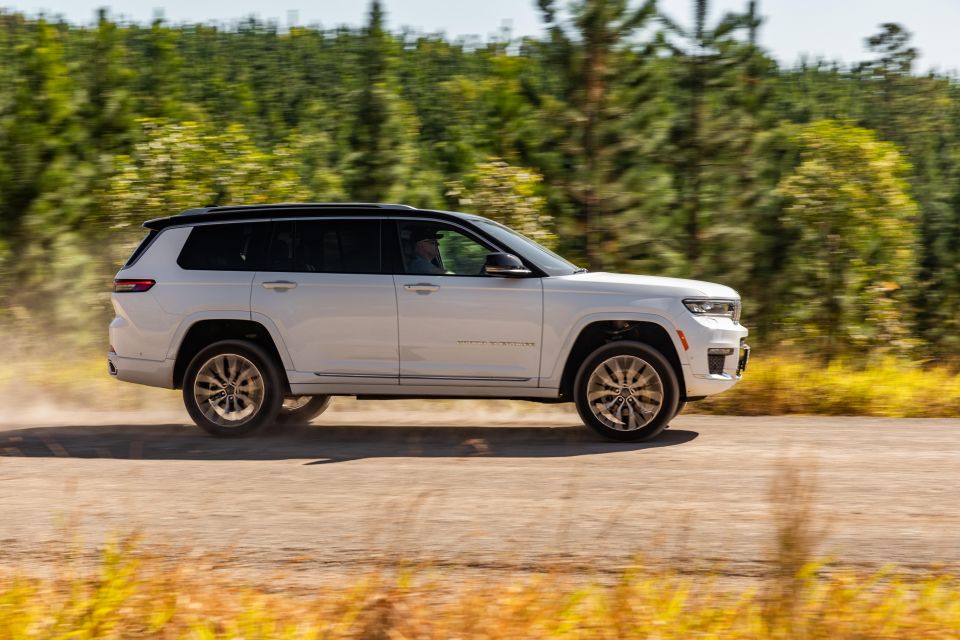
That’s especially unfortunate as the Jeep is a surprisingly good steer for something so large. The steering is more heavily weighted and car-like than the Patrol’s, and the underpinnings – reportedly sharing a thing or two with Alfa Romeo’s Giorgio platform – make this a vehicle you can push to greater limits than the Patrol.
Indeed, the Grand Cherokee has generally quite poised dynamics, and I quickly became very comfortable driving it around town. It also avoids feeling too isolated from the road.
The Jeep has a generally comfortable ride and wafts along the road, though its damping is a touch firm and there’s a bit of extra rebound – even with the air suspension on its default setting – that sees it take a second or two to settle after a road imperfection. This gives the Jeep slightly more of a rugged off-roader feel on the road than your typical unibody SUV.
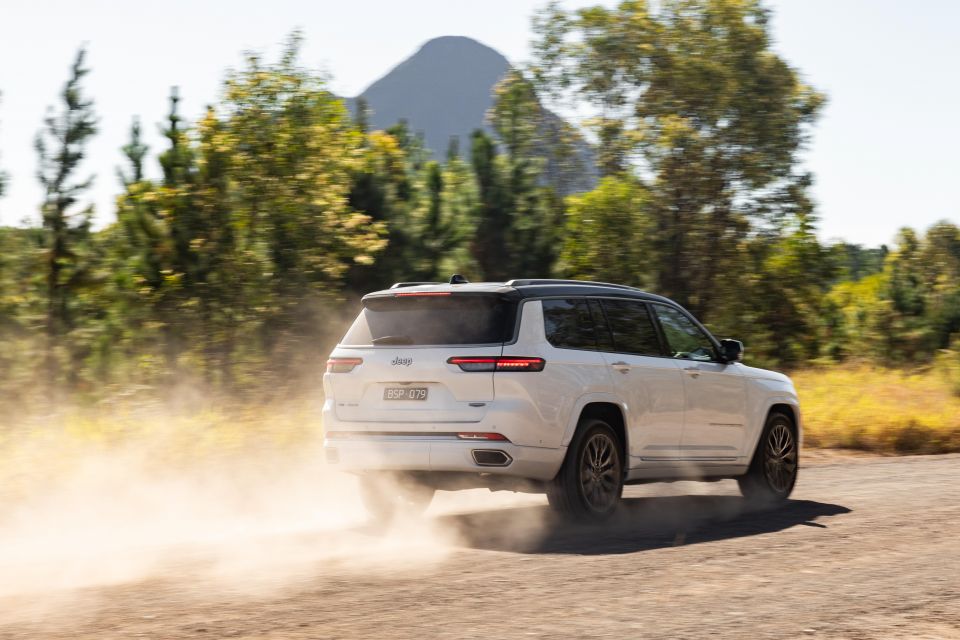
The Active Driving Assist system, which combines adaptive cruise control with a lane centring function, works quite well at keeping you in the middle of your lane and can creep through traffic.
It does, however, flash up warnings about lane detection ending whenever there’s a break in lane markings, despite its green lights staying on.
The lane support systems have various levels of adjustability. Only turning it completely off will silence the shrill beeps that occasionally sound when you depart your lane, though you can leave it turned on and toggle on and off the vibration and steering assistance.

The shrill beeping needs to go, as the vibration is more than sufficient and also doesn’t alarm your passengers.
The LED lighting, which includes handy LED cornering lights, provide plenty of illumination.
Less endearing was the rotary dial gear selector which, though pleasantly tactile, can’t be pushed into Park – you twist it instead, like you would to get into Drive or Reverse. This makes it all too easy to accidentally knock it into Park, which automatically deploys the parking brake.
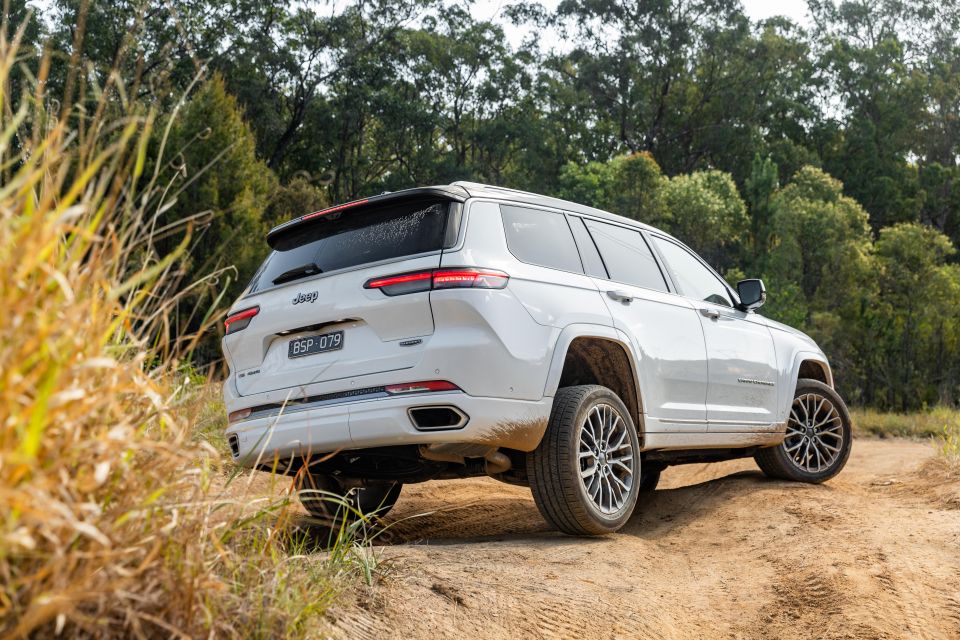
With no rear differential lock and 21-inch alloy wheels wrapped in low-profile tyres, it’s perhaps no surprise the Grand Cherokee L doesn’t feel as confident off-road as the Patrol.
The air suspension adds an extra 60mm of ground clearance in its highest setting, however, which certainly helps the Jeep, as does the presence of low-range gearing – neither feature can be found on the more affordable Night Eagle and Limited variants.
There are selectable Rock, Sand/Mud and Snow modes in addition to the Auto and Sport modes.

The Grand Cherokee L went everywhere we took the Patrol, though the absence of a rear diff lock was felt on the couple of occasions we had two wheels in the air.
Compared to virtually any other SUV bar the burly Patrol or a LandCruiser 300 Series, the Grand Cherokee L shines. In this match-up, though, it can only be runner-up.
This will go much further off-road than something like a CX-9, while feeling more car-like to drive than the Patrol. Jeep has therefore struck a good balance in terms of dynamics and capability – it just needs a better engine.
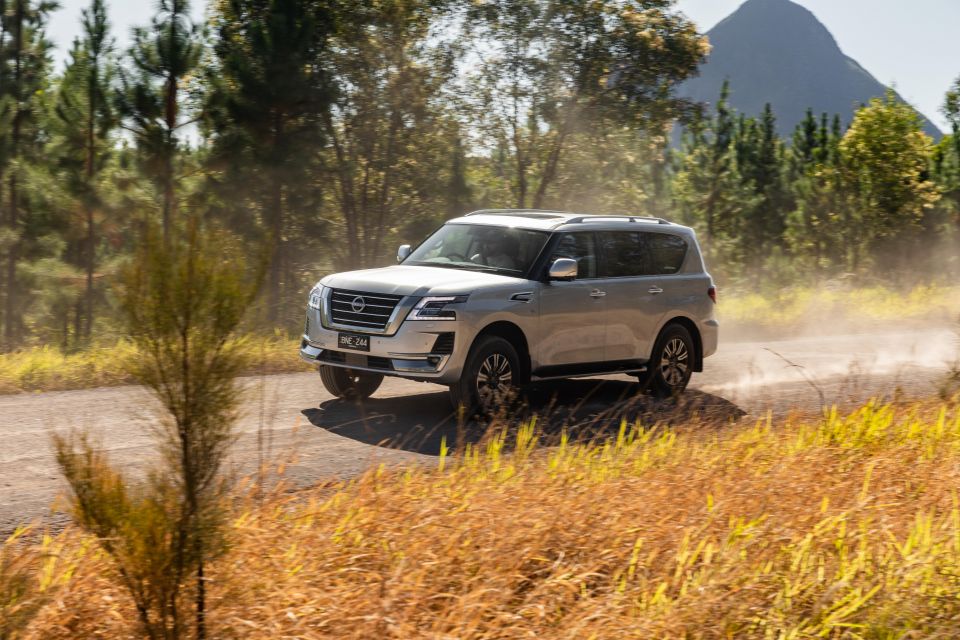
Patrol
In power and refinement, the Patrol shades the Grand Cherokee L.
The 5.6-litre V8 and seven-speed automatic make for a formidable pairing. Fun fact: they put this engine in the Infiniti Q70 sedan in markets like North America. It went like the clappers.
In the burly Patrol, it still makes for quick progress. There’s a delectable growl if you really plant your right foot, but what’s more impressive is just how quiet and refined the mighty Nissan is.
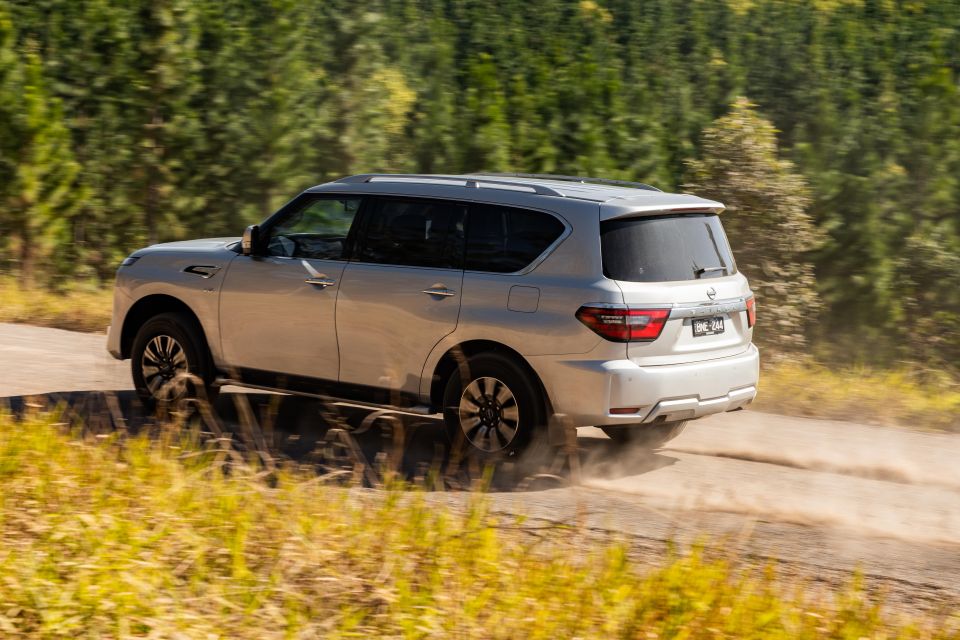
The seven-speed automatic shifts smoothly, while the cabin is supremely hushed. It’s so quiet at idle, you’d be forgiven for thinking it’s not running, while even at highway speeds there’s virtually no wind noise. This Nissan went to finishing school.
Handling is another matter. If the Grand Cherokee L is the athlete of this duo, the Patrol is the kid that got his mum to write him a note for PE.
That’s not exactly a surprise, given its more rugged, body-on-frame construction. Nevertheless, the Patrol’s limits are a lot lower than the Grand Cherokee L’s. Take a corner too quickly and you’re fighting physics itself as you grapple with the abundant body roll.

It’s also surprisingly easy to chirp the tyres if you apply too much throttle from a standstill, especially considering this has full-time four-wheel drive.
The Patrol’s a lover not a fighter, though, and it’s been calibrated to encourage gentle cruising.
The steering is loosey-goosey, being very light with lots of play. The light steering can be welcome, however, when you’re trying to manoeuvre this beast around tight urban confines like car parks.
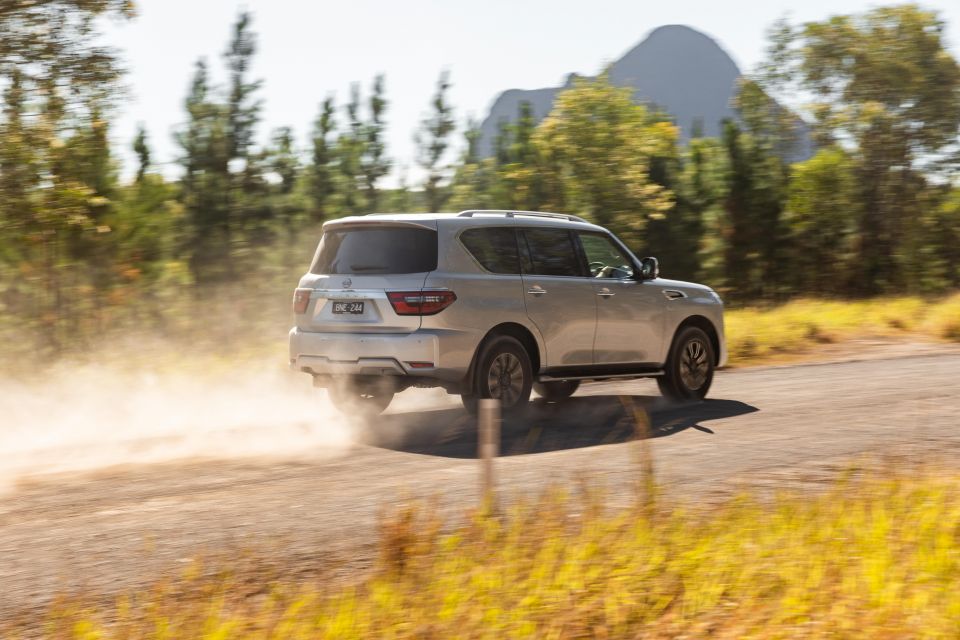
The ride is plush, generally floating over bumps. Speed bumps? What speed bumps?
Only when you reach sharper corrugations and more pockmarked roads does the Patrol get disturbed. We experienced significant rattling through the steering over some corrugated, unsealed surfaces, while the Patrol felt a bit fidgety over particularly pockmarked urban pavement.
There’s also the occasional frame shake you’ll encounter in a typical body-on-frame SUV. Overall, however, the Nissan is a comfortable cruiser, if floatier than the Jeep and taking a second or so longer to recover on undulating roads.
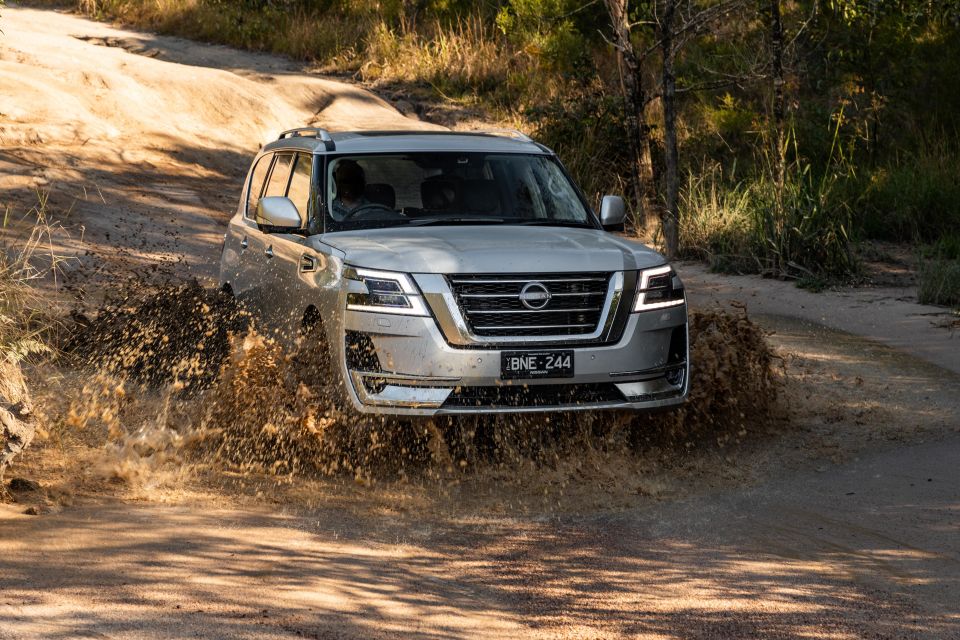
While there’s adaptive cruise control like the Jeep, there are no steering-based lane-support systems. Nissan does, however, feature something called Intelligent Lane Prevention.
It defaults to off, only works above 70km/h and relies on the brakes and not steering inputs. It’s subtle, but it doesn’t constantly feel like it’s making corrections – instead, it gives you a gentle nudge should you cross a lane marking.
Off the beaten track, the Nissan feels more at ease than the Jeep. The wheels are smaller and wrapped in tyres with thicker sidewalls, for one.
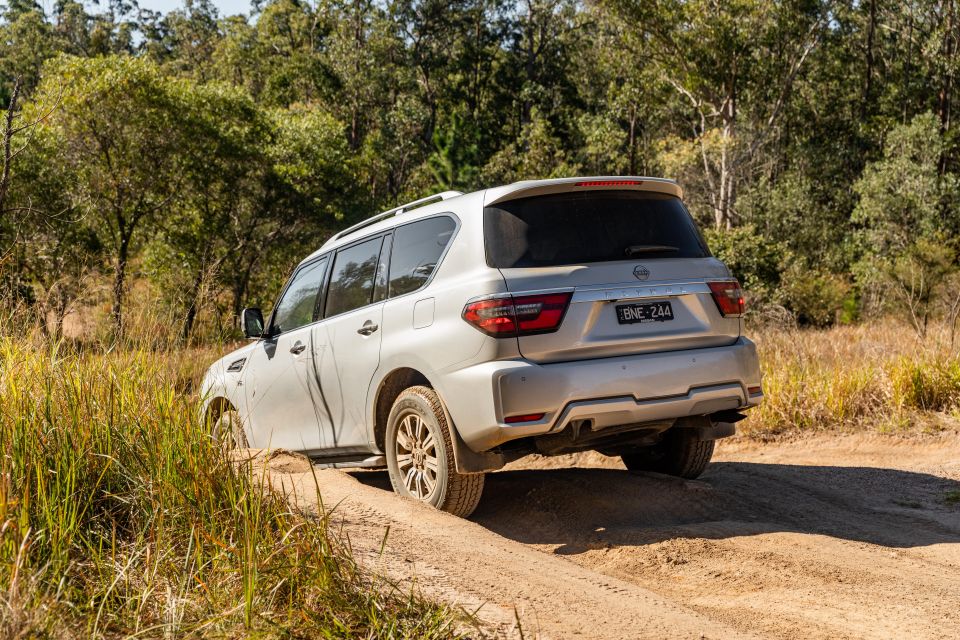
The Nissan also doesn’t need an air suspension set-up to jack it up, as its ground clearance is essentially equivalent to the Jeep in its highest air suspension setting. There’s also a locking rear differential for stickier situations, while like the Jeep there’s selectable low-range gearing.
There are no fancy off-road pages like in the Jeep, but there are still selectable modes for Sand, Snow and Rock.
Off pavement, the Patrol feels like the purpose-built four-wheel drive that it is.
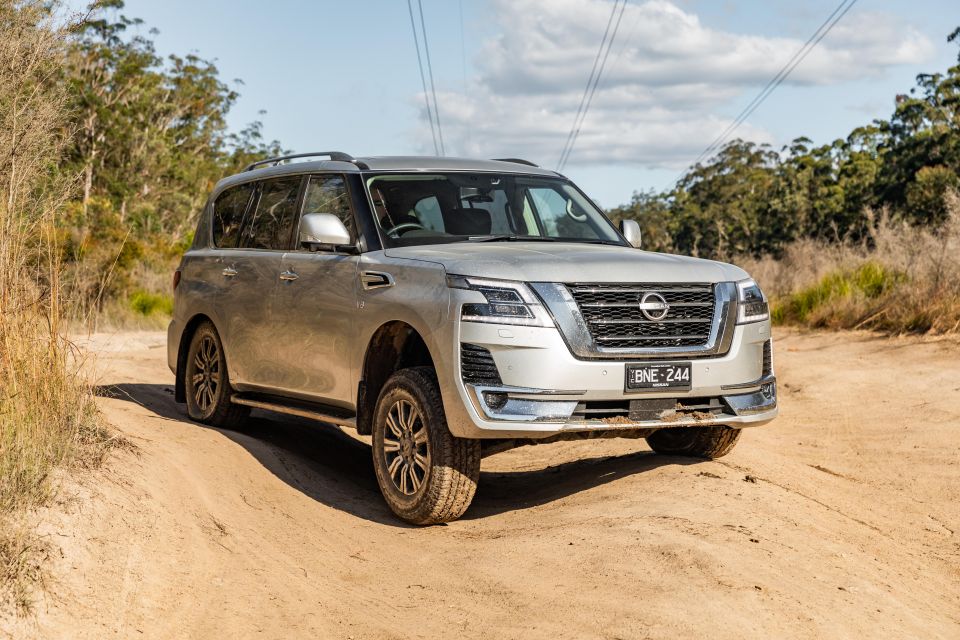

Grand Cherokee L
The Jeep is backed by a five-year, 100,000km warranty.
Servicing is required every 12 months or 12,000km, whichever comes first, and the first five services are capped at $399 each. That’s a total of $1995 over the course of five years.
Patrol
The Nissan is backed by a five-year, unlimited-kilometre warranty.
The company wisely adopted longer 12-month, 10,000km intervals for the Patrol earlier this year, banishing the old six-month intervals that few brands persist with outside of Toyota.
The first five services are capped at $393, $502, $483, $791 and $425, respectively, for a total of $2594 over five years.
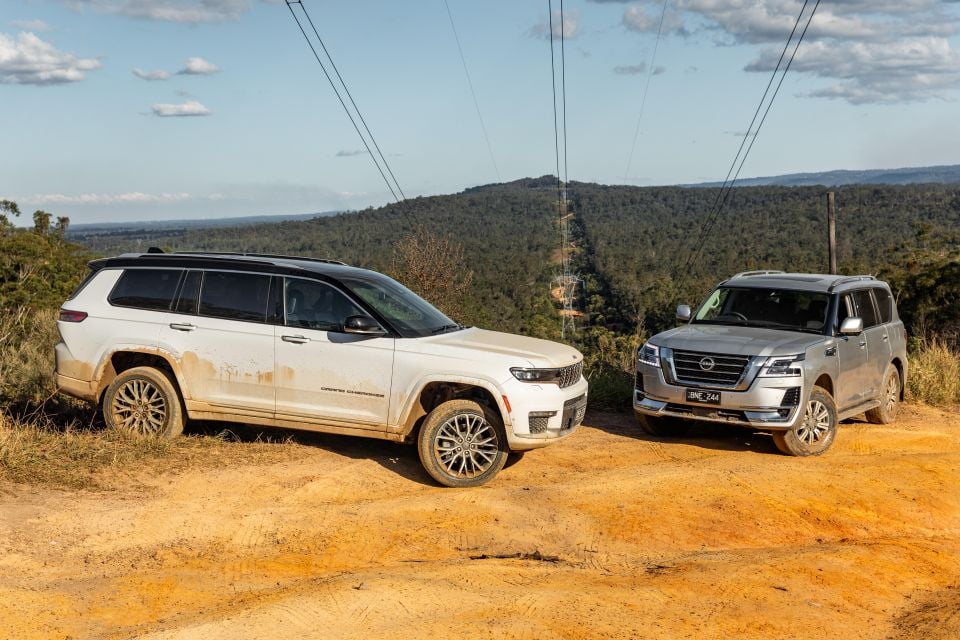
Looking at these two SUVs with the knowledge of what’s available overseas, you can’t help but feel frustrated.
Why, for instance, must the Nissan still be saddled with such outdated in-car tech in Australia? Why must the Jeep only be available here with the most underwhelming of the Grand Cherokee’s engines?
The Jeep frustrates further as, not only has the brand abandoned its loyal turbo-diesel and petrol V8 buyers and by extension those who tow heavy loads, it has also alienated its off-roading enthusiast audience to some degree.
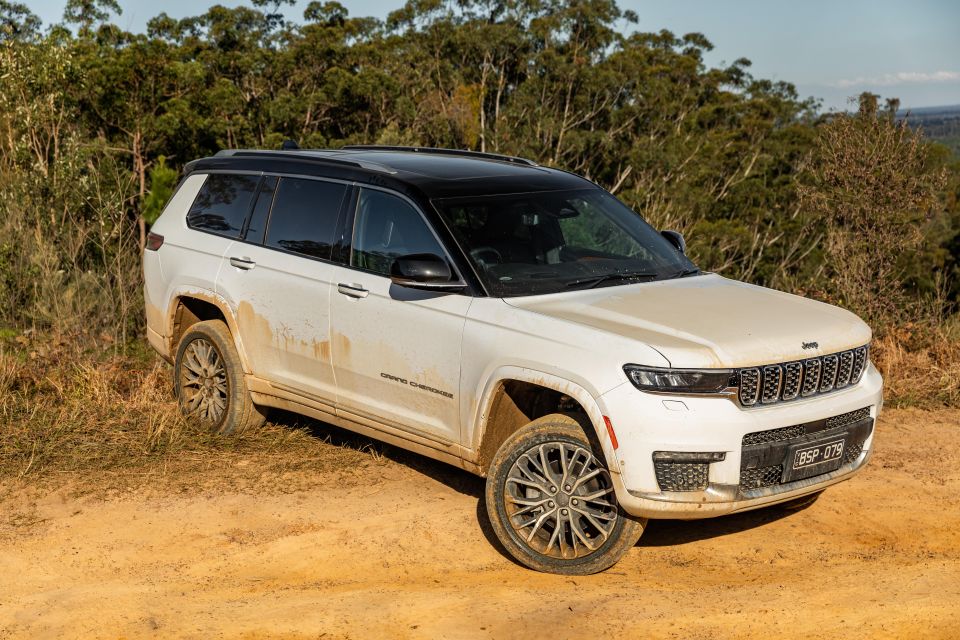
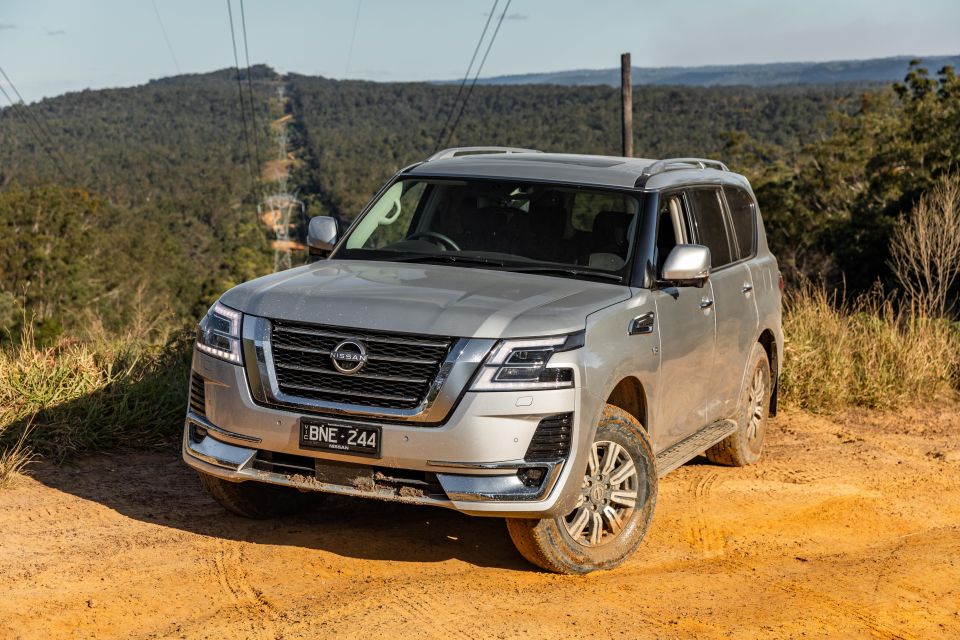
To get a Grand Cherokee L that can measure up against the Patrol off-road, you have to step all the way up to the pricey Summit Reserve. There’s no way to get an L with low-range gearing or air suspension below $100,000. Let’s hope they don’t make the same mistake twice with the upcoming two-row model.
Its material quality could also use some finessing, while the petrol V6 is adequate but no more. Jeep said you need to reconsider how much towing capability you really need. We’d argue you need to consider its wide range of rivals.
There’s a lot to like about the Jeep, mind you. Its cabin is more comfortable, it boasts more car-like handling, it’s cheaper to service, and its technology is miles ahead of the Nissan’s – even if we did encounter a few bugs.


And yet it must frustrate Jeep that the outcome is so close, considering just how old the Nissan is. Despite its senior citizen status, the Patrol has better material quality and a generally higher level of refinement. Throw in its basic off-road goodness and its superior towing capability, and that’s enough for many buyers to stick with this old favourite.
The Jeep needs a price adjustment or a new engine or both, while the Patrol needs the new interior offered in left-hand drive markets. Both vehicles, therefore, fall short of their potential.
If you want an SUV that’ll go anywhere and haul anything, within reason, the Patrol is our pick. If you don’t require that level of capability, the Jeep nudges a win – if one with a big asterisk next to it.
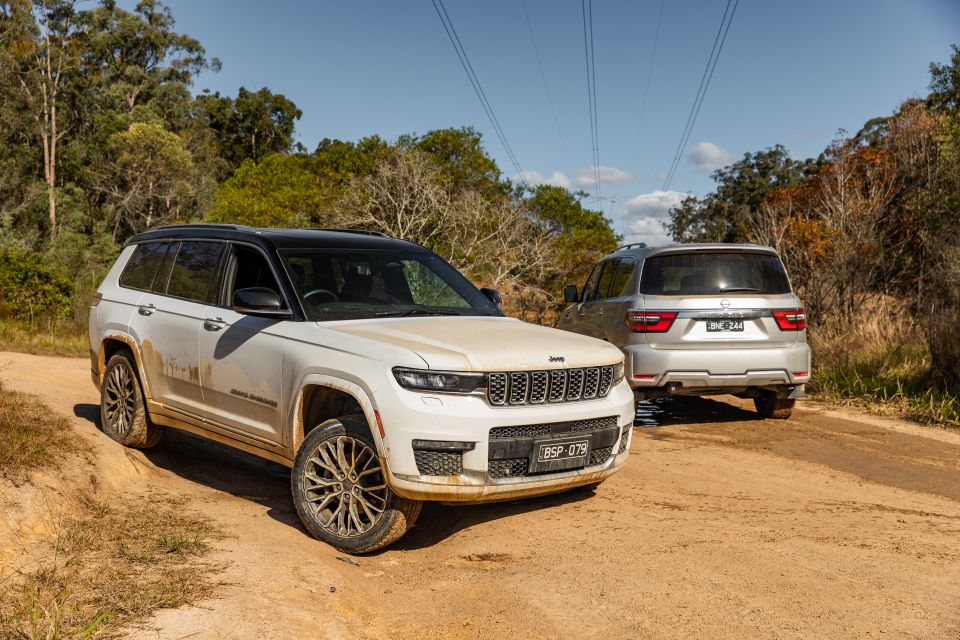
Click the images for the full gallery
MORE: Everything Jeep Grand Cherokee MORE: Everything Nissan Patrol
Share your thoughts with us in the comments below!
William Stopford is an automotive journalist with a passion for mainstream cars, automotive history and overseas auto markets.
Share your thoughts and write a review of a car you own and get featured on CarExpert.


Damion Smy
8 Hours Ago


Damion Smy
9 Hours Ago


Damion Smy
11 Hours Ago


Damion Smy
13 Hours Ago


Damion Smy
14 Hours Ago


Damion Smy
15 Hours Ago